Industry
- Details
- Written by: Isabella Foster
The new paradigm that exists in the modern engineering industry is the replacing of fossil fuel burning machinery with renewable, zero-emissions technologies. There is a growing public call for the re-engineering of automobiles, aircraft, trains and more, to power them in more renewable ways. Mechanical engineering and electrical engineering are coming together to ‘reinvent-the-wheel’ and design new technologies that produce zero emissions.
New Zealand’s Ports of Auckland authority says that they will be debuting the world’s first all-electric tugboat. Ports of Auckland have been dedicated to finding alternatively powered vessels for quite some time. Tony Gibson, the chief executive officer of Ports of Auckland said in a press release:
“In 2016 we set ourselves the goal of being zero-emission by 2040. We set this goal because we recognize that urgent action is needed on climate change, and we wanted to be part of the solution. However, setting the goal created a tough challenge. We have a lot of heavy equipment, like tugs, and in 2016 there were no zero-emission options.”
The RSD-E Tug 2513 tugboat, unfortunately for Auckland Ports, was not available in 2016. However, Dutch shipbuilder Damen will be delivering their new tugboat to them in 2021. The tugboat will be just as powerful as the diesel tugboats that they have been using for years.
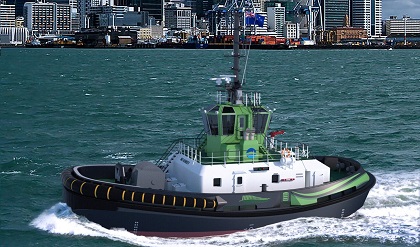
Damen was already engineering tugboat diesel-electric hybrids that Auckland Ports were utilizing but encouraged the company to work on an all-electric version. Damen design and proposal engineer Tugs Marc Baken said:
“We looked into the request and we saw that it was technically possible. The next step was to consider the feasibility of full electrical operation from a business perspective.”
What they had to do was look to battery technologies. They looked to what batteries were already on the market. They purchased those batteries and tested them out on crafts to see if they could test the efficiencies compared to the diesel alternatives.
They also found that the charging stations for the tugboats would be efficient. The tugboat will be utilizing a 1.5MW charger that will charge the tugboat up in only two hours. Seemingly, the technology is ready to deploy and could become a norm in the industry.
Damen says the batteries are stringed together so that if one battery fails, the next battery picks up the heavy lifting. Two 1000kW generators are on-board as well in case an electrical failure occurs - or if the tugboat has to tow something that is significantly bigger than what it usually tows. Damen wants to ensure people their all-electric with generators fitted in case of emergency is not a hybrid - they are confident the batteries will be able to power the tugboat at the same output as a diesel vessel.
Damen sales manager for the Asia Pacific region, Sjoerd de Bruin, said that the new tugboat will complete the green sustainability aims New Zealand has been aiming to achieve. He said:
“The RSD-E Tug 2513 completes the cycle of sustainability, being not only clean on emissions, but also in its source of power. This is great news for the region and also for other ports around the world with green ambitions. Ports of Auckland have taken a bold step in pioneering the use of fully electric harbor tugs and it is an honor to work with them on this project. This aligns neatly with our mission of reforming the maritime industry. We are not only building a tug, we are using disruptive technology to help serve the energy transition.”
- Details
- Written by: Elyse Simich
A future with flying cars might be closer than you think. On 5 August 2019, Japanese electronics firm NEC revealed their prototype for a giant drone, developed with their partner Cartivator.
Their electric Vertical Take-Off and Landing (eVTOL) aircraft weighs around 330 pounds and is equipped with four propellers. During a recent trial, the aircraft was able to lift itself 10 feet in the air and fly 65 feet before landing safely on the ground again. The whole trial lasted just less than a minute.
Last year, the Japanese Government announced a country-wide initiative for companies to build eVTOLs with driverless capabilities. They have granted Cartivator permission for outdoor flights, and the company plans to start mass-producing these in 2026.
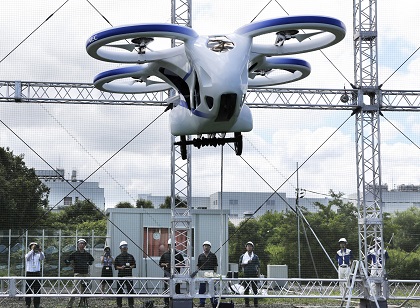
Speaking to Bloomberg, leader of the project at NEC, Kouji Okada, said, “Japan is a densely populated country and that means flying cars could greatly alleviate the burden on road traffic.
“We are positioning ourselves as an enabler for air mobility, providing location data and building communications infrastructure for flying cars.”
Electric vehicles are essential, as they produce far fewer carbon emissions than regular cars.
Japan is not the only country making headway with this technology.
In June, Uber announced that test flights for their ridesharing service would begin in 2020. Melbourne Australia will be the first city outside the US to test the service, joining other pilot cities Dallas, Texas and Los Angeles, California.
“Australian governments have adopted a forward-looking approach to ridesharing and future transport technology,” said Uber’s general manager for Australia, New Zealand, and North Asia, Susan Anderson.
“This, coupled with Melbourne’s unique demographic and geospatial factors, and culture of innovation and technology, make Melbourne the perfect third launch city for Uber Air. We will see other Australian cities following soon after.”
They have also joined hands with a company named Jaunt Air Mobility to make the Uber Air dream a reality. The eVTOL resembles a helicopter which Uber Air is banking on to make their mobility plans possible.
Uber Elevate Director of Engineering, Mark Moore, said in a press statement, “Jaunt Air Mobility has assembled a highly talented team of experienced engineers with a long history of designing and certifying eVTOL vehicles.
Martin Peryea, Jaunt’s Chief Technology Officer, has led many helicopter development programs as a chief engineer and brings invaluable to developing low noise, reliable, and safe aircraft.
“I look forward to seeing what our teams accomplish together as we aim to accelerate Jaunt’s commercialization efforts.”
According to Inverse, there are now 120 eVTOL projects being tested worldwide. While there are still barriers to overcome, they predict limited commercial flights will be up and running within the next five-to-ten years.
- Details
- Written by: Quintus Potgieter
Homelessness is a global issue on the rise with a new estimate of 1.2 billion people worldwide lacking access to safe and secure housing at any given time. However, a construction-technology startup is proposing to build 3D-printed homes in 24 hours and for under $4,000, a new and possible solution to homelessness.
CEO of Fuseproject, designer Yves Behar has revealed plans to build 3D-printed houses for an impoverished farming community in Latin America. Fuseproject, has teamed up with non-profit organisation, New Story, to bring the project to life.

On the Fuseproject website, their mission is laid out:
“It is our belief that designers, builders and technology innovators have the potential to bring unprecedented speed and scale to housing design that can elevate the lives of some of the most impoverished populations around the globe. 3D printing, in particular, offers a new and powerful tool for realizing this potential and driving this mission forward.”
The 55-square-metre houses will be printed with portable, autonomous printers which use a robotic gantry system to pipe concrete over the designated print area. Their inbuilt industrial control software follows the print instruction and works through both the day and night without the need for extensive labour.
The house will be one part of a greater 120-square-metre property that includes a covered outdoor kitchen and dining room, and gardens free for resident use.
The design of the houses was also made with the difficult climate in mind. The houses feature a large curved roof that extends beyond the front and the back of the house to act as a buffer against the heavy rainfall. Perforated concrete blocks will also run along the top of the walls to allow for a natural ventilation system.
The companies plan to work collaboratively into the future towards a goal of having built an entire community of the 3D homes by 2020.
“We feel it’s our responsibility to challenge traditional methods. Linear methods will never reach the billion-plus people who need safe homes,” says Brett Hagler, CEO of New Story.
“Challenging our assumptions, iterating based on data, and taking calculated risks on innovative ideas will allow us to reach more families with the best possible solutions, exponentially faster.”
Technology company ICON has provided portable, autonomous printers to create the houses. This technology produces nearly no waste.
The printer uses a robotic gantry system that pipes concrete (or as they call it ‘ICON Lavacrete’) over the print area. Industrial control autonomously follows the print instructions and works without the need for extensive labor. ICON says the entire setup is the first digital-native approach to building construction.
The printer can also function in low-light conditions thanks to onboard LED lighting. Thus, the printer can be utilized even after hours — providing even further evidence that this form of construction offers incredible value for the construction company.
Works Cited
“Yves Béhar Teams with Tech-Infused Charity for World's First 3D Printed Community.” Archinect, archinect.com/news/article/150135707/yves-b-har-teams-with-tech-infused-charity-for-world-s-first-3d-printed-community.
“Fuseproject.” Fuseproject, fuseproject.com/.
- Details
- Written by: Quintus Potgieter
The industrial sectors of the engineering world are currently amidst a period of incredible progress. With the introduction of more automated processes than ever before, the industry is becoming increasingly efficient and requiring less physical manpower.
However, the digital transformation of the industry does come with its downsides. When integrated with technology, vital industry hardware becomes connected to the internet, which makes the chances of corruption far more likely.
Fortinet is an American multinational company that develops cybersecurity software in the engineering sector. They recently released a report entitled the ‘2019 Operational Technology Security Trends Report’, which examined troublesome cyber-attacks, specifically targeting supervisory control and data acquisition (SCADA) and industrial control systems (ICS) systems.
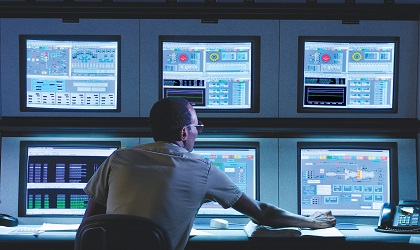
In the report, Fortinet says that two-thirds of global operation technology is connected to an interconnected network. 32% of the systems are connected to the public internet, and the other 32% connected through a gateway into the enterprise. Fortinet writes, “This gateway is sometimes as innocuous as a single PC that is separately connected both to the OT system and the internet.’
Those systems are directly vulnerable to attacks. The report also found that in 2018 exploits ‘increased in volume and prevalence’ for almost every ICS/SCADA vendor. Meaning, hackers were attempting to find vulnerabilities in ICS and SCADA systems. Once vulnerabilities are found, it is up to companies to ‘patch’ the particular vulnerabilities.
Just recently in July 2019, security researchers published a list of 11 vulnerabilities that needed urgent attention by cybersecurity specialists - they aptly named the vulnerabilities the Urgent11.
Larry O’ Brien, vice president of the ARC Advisory Group - a leading technology research and advisory firm for industry wrote:
“Cybersecurity is playing an increasingly important role in process safety systems. This became apparent with the cyber-attack on safety systems late in 2017 that ultimately ended in the safe shutdown of a Middle Eastern petrochemical facility. Attacks on safety systems have the potential to cause real harm in the physical world, so it’s important that ICS/SCADA cybersecurity policy include rational approaches to process safety systems.”
Lessons are being learned every year, but it seems that businesses will have to invest in cybersecurity at a more rapid rate due to the quick nature in which new exploits arise. The engineering industry needs to learn how to secure their systems from the hacker-types who are technically gifted enough to discover those loopholes.
INSINIA, a company specializing in cybersecurity for enterprise and industry in December 2018 spoke about the hacking of industrial control systems at the Security BSides London conference. They presented a lecture entitled: ‘Hacking SCADA: How We Attacked a Company and Lost them £1.6M with Only 4 Lines of Code’.
The group developed a ‘weaponized’ Arduino micro-controller that could scan a network and shut down components in an interconnected setup, powered by only four lines of code. They showed how easy it could be to take down an industrial setup in minutes.
The group says that in their research of certain companies running industrial control systems, some were found to be using Windows 7, and in some cases even Windows 98 as operating systems. The issues being that older operating systems can be vulnerable to backdoor attacks that are unlikely to be patched as new operating systems have made their way to market.
The onus seems to be on the engineers of companies to source enterprise-level systems with apt cyber-security to combat the denial-of-service attacks hackers attempt to exact on SCADA and industrial control systems.
Works Cited
“Deliver Secure Digital Transformation.” Fortinet, www.fortinet.com/.
Leyden, John. “Pwned with '4 Lines of Code': Researchers Warn SCADA Systems Are Still Hopelessly Insecure.” The Register® - Biting the Hand That Feeds IT, The Register, 20 June 2018, www.theregister.co.uk/2018/06/18/physically_hacking_scada_infosec/.
- Details
- Written by: Quintus Potgieter
Most technologies have something in common: heat generation. For example, engines, electronics, light bulbs, and machinery all create thermal radiation while running.
Any heat not utilized is wasted energy. Imagine re-using that thermal radiation and turning it into something that benefits the technology itself.
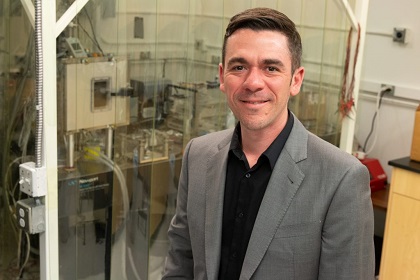
One engineer has found a way to use his ‘wasted’ energy. He has created a device that takes such wasted energy and pumps it back into the original technology.
University of Utah mechanical engineering associate professor Mathieu Francoeur and his team have produced what is known as a ‘Near-Field Radiative Heat Transfer Device.’ Their device purportedly surpasses what is known as the blackbody limit.
A blackbody limit is the maximum amount of heat that can be emitted from an object. Francoeur said, “Nobody can emit more radiation than the blackbody limit. But when we go to the nanoscale, you can.”
The researchers put together a 5mm-by-5mm chip that had two silicon wafers with a nanoscopic gap between them. The proximity of the silicon wafers allowed the researchers to test how much more functional electricity could be generated to power the original object. The closer the wafers were, the more electricity they generate.
Francoeur suggests that further development of the chip means laptops could enjoy 50% more battery life, and photovoltaic solar panels could produce more electricity. The other benefit is that heat-emitting technologies would run at cooler temperatures, preserving their lifespans.
“You put the heat back into the system as electricity,” he said.
“Right now, we’re just dumping it into the atmosphere. It’s heating up your room, for example, and then you use your AC to cool your room, which wastes more energy.”
Works Cited
“Beat the Heat.” UNews, unews.utah.edu/beat-the-heat/.
Uofunews. “Beat the Heat.” EurekAlert!, www.eurekalert.org/pub_releases/2019-07/uou-bth070819.php.
- Details
- Written by: Quintus Potgieter
Amazon is moving forward with a plan to launch thousands of satellites into space in order to bring reliable broadband internet service to rural areas across the globe.
Amazon subsidiary Kuiper Systems has applied with the United States Federal Communications Commission (FCC) to launch more than 3,000 satellites into space under the name Project Kuiper.
The application states, “The effective implementation of global broadband services requires more than the design, construction, and deployment of the technologically advanced satellite system, low-cost customer terminals, and gateways. It also requires worldwide terrestrial network infrastructure and customer operations capabilities.”
“The Kuiper system will help bridge gaps in coverage by complementing the efforts of terrestrial fixed and mobile careers and reaching some of the most remote and hard-to-reach areas - where it is often geographically difficult of cost-prohibitive for terrestrial service providers to operate today.”

Kuiper Systems Chief Executive Officer is Rajeev Badyal — SpaceX’s former vice president. Interestingly enough, SpaceX launched 60 satellites into orbit on 23 May 2019. Their satellites are also intended to provide internet service worldwide.
The name of SpaceX’s project is Starlink — and they are cleared to launch a total of 11,943 satellites. Chief Executive Officer Elon Musk says the plan is to launch 60 satellites at a time. He predicts they will achieve global coverage after 24 launches.
It would appear that these companies are involved in a satellite space race.
Amazon Chief Executive Officer Jeff Bezos said the internet satellites are a long-term project. For engineers, the project presents an incredible opportunity
While astronomers are worried that more satellites in space may begin obscuring some of the star systems they study, educators that do not have their eyes on the skies are thinking an interconnected world means more opportunities for education and training.
With more people connected to the internet globally, the chance for online education and training will naturally follow. Those in rural areas who cannot afford to move to a city for university could benefit from earning tertiary degrees through online means. Low-cost communication technologies and low-cost internet service provided by satellites could transform multiple careers around the world.
Works Cited
Brodkin, Jon. “Amazon Plans Nationwide Broadband-with Both Home and Mobile Service.” Ars Technica, 8 July 2019, arstechnica.com/information-technology/2019/07/amazon-follows-spacex-into-satellite-broadband-asks-fcc-to-ok-launch-plan/.
- Details
- Written by: Quintus Potgieter
Machine learning and artificial intelligence could be the key to simplifying project management.
As it stands, engineering project management is an arduous process. Many factors need to be considered, including project lifecycle, scheduling, costs, and quality management.
However, engineers in the Silicon Valley are coming to the rescue. Tara.ai is a project management platform that aims to enable product teams to be on time and budget. The company has just raised US $10 million in capital to continue its development.

A report by global management consulting company McKinsey, discovered that US $66 billion was “lost” across 5000 separate projects. This was due to them exceeding their lifecycles, poor planning, and the wasteful expenditure on the wrong kind of talent. Now one of McKinsey’s ex-employees, Iba Masood, is a co-founder of Tara.ai.
One of the more interesting features of Tara.ai is the recruitment section, which ensures the right people are working on each project.
“We realized that recruiting was actually the final decision you make, not the first, and we wanted to be involved earlier in the decision-making process,” Masood told Techcrunch.
“We saw a much bigger opportunity looking not at the people, but at the whole project.”
Once team members have been recruited for a project, Tara.ai can recommend the right people for each specific task.
On their website, the company explains, “with Tara.ai, you know the right person for the right task. Integrations create dynamic profiles for team members such as engineers and designers, so they can be easily recommended for tasks and objectives.”
This means the responsibility falls on the engineers to ensure their CV stands out when they are applying for jobs.
Steve Mackay, the Dean of Engineering at the Engineering Institute of Technology, gives the following advice: “First of all, ensure your CV is designed for the particular job you are applying for. Most people think they can use a generic resume because they have to apply for lots of jobs. This is not advisable. Be specific! Focus on the job you really want. Your CV should also include business strengths and business wins.”
It’s important to note that while certain platforms can guide you through each project, machine learning and AI are still no match for a competent human project manager. The individual in charge of managing the project still needs to be driven and competent to ensure the project runs smoothly.
This is why the Engineering Institute of Technology offers an interactive three-month online course that specializes in helping students develop the required leadership and management skills to successfully oversee a project.
Project managers do not have to wait for the software that leverages the team’s time and expertise. Streamlined project management tools are already in existence. Cloud-based software communications and project management platforms like Slack or Atlassian Jira are helping projects move along efficiently across the globe.
Tara.ai is hoping that they can take it even further.
Works Cited
Lunden, Ingrid, and Ingrid Lunden. “Tara.ai, Which Uses Machine Learning to Spec out and Manage Engineering Projects, Nabs $10M.” TechCrunch, TechCrunch, 1 July 2019, techcrunch.com/2019/07/01/tara-ai-which-uses-machine-learning-to-spec-out-and-manage-engineering-projects-nabs-10m/
- Details
- Written by: Quintus Potgieter
Bicycle-sharing companies are rapidly seeing a drop-off in customer interest.
At least three bike-sharing businesses have recently stopped operating in the United Kingdom. The companies themselves, some of them from China, are starting to cease operations in their home countries as well.
oBike was a Singaporean bicycle-sharing company that kicked off their operations in 2017 in several countries. Unfortunately, in 2018, the parent company of oBike filed for insolvency.
Another bicycle-sharing company that saw a substantive reduction in operations in 2018 was the Beijing-based company, Ofo.

oBike has subsequently pulled out of Singapore (and other countries), leaving much of their bicycle stock behind.
But the engineering technology left behind from unsustainable businesses can be efficiently utilized by someone else.
That’s where budding Myanmar-born entrepreneur Mike Than Tun Win comes in. He had an idea about what the bicycles could be used for once the bicycle-sharing businesses were closed down.
“What if these bicycles could be distributed to poor students in villages so they can cycle to school?” he said.
“I thought if we could just reduce the time they take, they could spend more time studying, gain more knowledge and increase their chances of getting out of poverty.”
He began a movement called LessWalk in March of 2019. He figured that if Ofo and oBike auctioned their bicycles off after ceasing operation, he could purchase them at a fraction of the cost.
He travelled to China and saw incredibly sized ‘graveyards’ of bicycles from the bicycle-sharing companies — some had never even been used before.
“Seeing the graveyards in China was really the tipping point for me,” he said.
“I was stunned when I saw so many bicycles, 30,000 to 50,000 of them just piled up. It’s astonishing because some bicycles were in good condition, their brake pads were brand new, and some were hardly used.
“To think that these bicycles would be dismantled and sold for around [$8 to $10] to the recycling companies, I just thought it was quite wasteful as the bicycle originally costs so much more to make.”
To date, he has bought 10,000 bicycles. He also made a deal with the Ministry of Education in Myanmar who will help distribute the bicycles to the villagers for free. Soon, more sponsors jumped on board to assist with buying more bicycles for Mike to refurbish and modify.
Mike intends to fit an extra seat onto the bicycles, so one bike rider could transport a passenger too. He says that it would greatly help children and their siblings from the villages.
LessWalk is showing what could be possible if the world adopted a circular economy. If more engineering companies could subscribe to some of its principles, there could be more life-changing technology for all. The theory sets out an economic system aimed at minimizing waste and making the most of resources.
Thanks to Mike Than Tun Win, what was destined for the trash heap became an opportunity to re-utilize technology and give it a second life. As LessWalk puts it, a first world problem has become a third-world opportunity. The result has been a wonderful act of charity that is going a long way and improving the lives of the people in Myanmar.
Works Cited
“Entrepreneur Buys Unused OBike and Ofo Bicycles to Donate to Poor Children in Myanmar.” TODAYonline, 4 June 2019, www.todayonline.com/singapore/entrepreneur-buys-unused-obike-and-ofo-bicycles-donate-poor-children-myanmar.
“Turning Bike Sharing Problem into Opportunity.” Lesswalk, www.lesswalk.org/.
- Details
- Written by: Quintus Potgieter
Troublesome civil engineering anomalies in Australia’s New South Wales are generating some bad press for the region. The news is that some recently constructed residential skyscrapers may not have been constructed according to national standards.
The figurative alarm bells began ringing for Australians on Christmas Eve in 2018. Sydney Olympic Park was evacuated once cracks were discovered in the Opal Tower, making residents fear that the building was on the verge of collapse. Construction of the Opal Tower was only completed in early 2018.

The New South Wales government then opened a commission into the Sydney Opal Tower. What they found was that the building was overall structurally sound, but horizontal beams were not strong enough and did not comply with national standards. On top of that, design and construction failures were evident. Lower strength concrete on the fourth level of the building was also flagged by the commission.
The unfortunate consequence of the evacuation of the building and the commission’s report is that some residents will not be returning. According to News.com.au, 200 of the 400 units remain empty, with some residents saying they will be permanently staying away.
The engineers brought in by the commission have instructed the government to create a database of registered engineers who would not cut corners and stick to NSW building standards in hopes that a future disaster can be prevented.
On Friday the 14th of June 2019, another building was evacuated. This time, it was the Mascot Towers in Sydney, a twelve-year-old 131-apartment block. Engineers ordered the evacuation due to cracks which had formed, indicating that an emergency repair was needed.
Documents uncovered from the Owners Corporation at the Mascot Towers revealed that there were concerns about the structural integrity of the building months ago.
This story seems to be echoing what is happening globally in select civil engineering companies. Engineers Australia said Opal Tower and Mascot Towers serve as evidence that changes in legislation are needed in the building and construction sector.
The cutting of corners is being exposed worldwide. Structural engineers are cognizant of the failures that occurred at Grenfell Tower in the United Kingdom and are looking to prevent further catastrophes of a similar kind. Sticking to strict building codes is imperative.
However, data from the University of South Wales’ City Futures Research Centre generated in 2015 revealed that 85% of new apartment buildings built since 2000 in New South Wales had construction defects. It seems there is more work to do to enforce transparency and due process into the construction industry.
Works Cited
Charlie Moore For Daily Mail Australia. “'This Is so Dodgy': David Koch Slams the Government over Mascot Towers.” Daily Mail Online, Associated Newspapers, 17 June 2019, www.dailymail.co.uk/news/article-7151609/This-dodgy-David-Koch-slams-government-Mascot-Towers.html.
“Hundreds Still Homeless at 'under Designed' Opal Tower.” News.com.au, 25 Feb. 2019, www.news.com.au/finance/business/other-industries/opal-tower-report-blames-damage-on-multiple-design-and-construction-faults/news-story/4ce37fc18ebe986aab19217ddadc124a.
- Details
- Written by: Quintus Potgieter
Researchers at Cornell University have taken engineering inspired by nature to a whole new level.
In a newly published study in the Nature Journal, the researchers detail how they engineered a silicone fish-like robot with a circulation system powered by a liquid battery — or as they like to call it, ‘blood’. Their study’s name is: ‘Electrolytic vascular systems for energy-dense robots’.
Designing robots in this fashion helps engineers learn how soft, flexible robots perform in different environments. Robert Shepherd, an associate professor at Cornell’s Sibley School of Mechanical and Aerospace Engineering speaking to Popular Mechanics said, “I thought of this robot when I was at a workshop about avian-inspired aircraft.
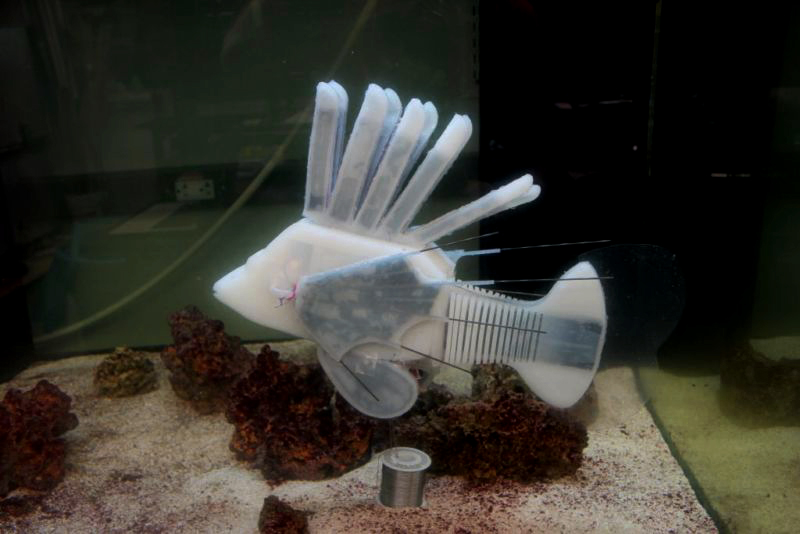
“Some of the examples from biology included the Bar-tailed Godwit, which can fly for a week or more at a time without stopping.
“The blood in our bodies also performs multiple functions — delivering energy and removing waste, and it is simultaneously pumped by our heart and powers our hearts. The completion of this story arc was matching the blood concept with the mechanics of the hydraulically powered soft robots my lab makes.”
The engineers are experimenting with Redox Flow battery technology. These batteries are a type of electrochemical cell where energy is provided by two chemical components contained within the system that are dissolved in liquids and separated by a membrane. The engineers hope the robot can inspire other applications for soft-robots powered by the flow batteries.
The engineers managed to hydraulically pump the chemicals throughout the robot, maintaining its shape, but helping it move as well. The robot can run for 36 hours before needing to recharge, in part thanks to the battery fluid that not only acts as a hydraulic fluid but also energizes a pump that moves the fins, allowing the fish to ‘swim’.
The authors of the study are hoping that their findings in this fishy experiment eventually lead to reforms in modern robots and their energy storage systems. They write, “Modern robots lack the multifunctional interconnected systems found in living organisms and are consequently unable to reproduce their efficiency and autonomy.
“Energy-storage systems are among the most crucial limitations to robot autonomy, but their size, weight, material and design constraints can be re-examined in the context of multifunctional, bio-inspired applications.”
And so, the engineers worked to pack as much as they could into the thin 40-centimetre soft casing. The team has successfully cut down on the weight that other batteries would have added to their fish robot. They note in their journal that there are still some kinks to work out. However, if they can encourage the powering of robots in more flexible and lightweight sources, their contribution will be invaluable.
Works Cited
Hernandez, Daisy. “This Robotic Fish Is Powered by a 'Blood' Battery.” Popular Mechanics, Popular Mechanics, 21 June 2019, www.popularmechanics.com/science/a28120444/robotic-fish-blood-battery/.
Lu, Donna. “Robotic Fish Powered by Electronic Blood Can Swim for 36 Hours.” New Scientist, www.newscientist.com/article/2207175-robotic-fish-powered-by-electronic-blood-can-swim-for-36-hours/.
- Details
- Written by: Quintus Potgieter
Kenya is becoming a hotspot for engineering innovation. Keen future engineers have been busy inventing, whilst simultaneously trying to get qualified in their country. They are doing this in the hope of benefitting Kenya’s future and working to solve its societal problems.
Roy Allela, a Kenyan software engineer, was inspired by his deaf niece to create something that would help him communicate with her better. He named the gloves Sign-IO, a wearable technology that can translate sign language for those who do not understand it. And now he is at work trying to make it more available for the broader public.
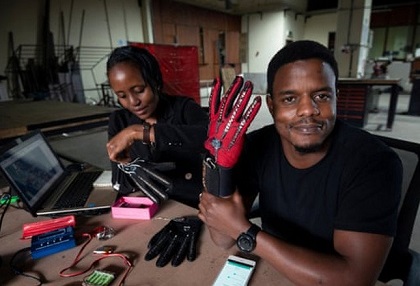
On his personal website, he wrote, “I have a background in Microprocessor Technology and I love doing moonshot projects with an interest in Machine Learning, Deep learning and the Internet of Things.”
His project won the American Society of Mechanical Engineers (ASME) grand prize in 2017. Engineers from the USA and India were also present, but it was Kenya that reigned supreme. The glove was also the runner-up at the Royal Academy of Engineering Leaders in Innovation Fellowship in London. It is now in the running for the awarding of the home-based Africa Prize for Engineering.
Allela is refining the portability of his gloves and is continuing to update it as he goes along so he can create the best, most market-ready prototype. The glove is built on the back of Intel’s Edison, which allows it to be mapped via what is called a Support Vector Machine. The machines implement machine learning algorithms that can learn and store the sign language used inside the glove.
The glove has five flex sensors mounted on each finger which Allela says ‘quantifies how much a finger is bent’. An Android companion app running a text-to-speech engine picks up the gestures being processed and vocalizes what the person is saying.
Allela’s niece has been his test subject for the gloves. Speaking to This Is Africa he said, “My niece wears the gloves, pairs them with her phone or mine, then starts signing.
“I’m able to understand what she is saying. People speak at different speeds and it’s the same with people who sign — some are really fast, others are slow. So we integrated that into the mobile applications so that it’s comfortable for anyone to use.”
Allela hopes that the gloves will help fight stigmas attached to the deaf community. And he says that he has tried to make the gloves look as cool as possible so kids will not be bullied for wearing them. He aims to have at least two pairs of gloves in every special-needs school in Kenya, according to This Is Africa.
Works Cited
Admin, ~. Roy Allela, www.royallela.com/iot/sign-language-glove/.
- Details
- Written by: Quintus Potgieter
HBO’s latest drama, Chernobyl, recently concluded its short 5 episode run, drawing global attention to one of the biggest engineering failures of human history. Before the finale of the TV show aired, the show was enjoying the number one spot on the IMBD television show rating list, making it one of the most highly rated television programs of all time.
The captivating series gave a window into the 1986 crisis, constantly reaffirming the severity of the disaster with every passing episode. Olesksiy Breus, one of the original engineers at Chernobyl, said the TV show did manage to portray the explosion and the effects of radiation on the body accurately.
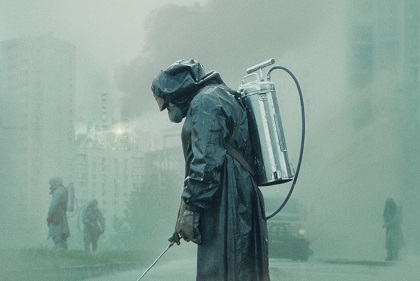
Nonetheless, the television series dramatizes the supposed complicity of the Russian government in the nuclear disaster. The showrunners charge the government with putting cronies in positions that should have been watchdogs over the nuclear reactors and charges the government with buying cheap nuclear reactor technology in order to save money.
The show points to the RBMK reactors, a class of graphite-moderated nuclear power reactors that were designed by the Soviet Union, as the key to the problem at Chernobyl. They portray the behaviour of the reactor at low energy levels and a mishandled safety test as the cause of the disaster.
However, Russian government sources dismissed the TV show as a reliable retelling of what went wrong at Chernobyl. Russian television producers are now allegedly preparing to make their own TV show with their own spin on the events.
HBO’s Chernobyl seems to have done what it was setting out to do; revive the discussion of the safety of nuclear energy. Hesamedin Ashena, a presidential adviser from the Center for Strategic Studies in Iran tweeted about the Chernobyl television series saying:
“What is the cost of lies? Those in politics and government could learn from that mind-boggling question.”
Henry Fountain, a science writer on the Climate desk of the New York Times, who toured the Chernobyl plant in 2014, writes about the Chernobyl TV show in his article ‘Plenty of Fantasy in HBO’s Chernobyl, but the Truth Is Real’:
“For the mini-series gets a basic truth right - that the Chernobyl disaster was more about lies, deceit and a rotting political system than it was about bad engineering or abysmal management and training or, for that matter, about whether nuclear power is inherently good or bad.”
On social media, people have been pointing out other engineering failures and requesting that they are made into TV dramas, to show what could happen if other dangerous technologies go unchecked and unregulated.
Indian social media users began sharing a 2014 film named ‘Bhopal: A Prayer for Rain’. The movie focuses on the Bhopal Gas Tragedy. It is one of the biggest industrial disasters in modern history that occurred on December 1984. It was a gas leak incident at the Union Carbide India Limited pesticide plant which saw over 500,000 people exposed to a highly toxic gas called methyl isocyanate (MIC). The death toll was estimated to be over 3,000 people. A government affidavit in 2006 stated that the leak caused 558,125 injuries including 38,478 partial injuries.
The cause of the disaster is still a topic of debate in the country, and so, citizens are asking for a heavily researched and dramatic television show that could ignite a real conversation about the consequences that led to disaster. Engineering television dramas could become a welcome trend as the golden age of television continues its slow march.
Works Cited
“Chernobyl - Season 1.” HBO, 4 June 2019, www.hbo.com/chernobyl/season-1.
Fountain, Henry. “Plenty of Fantasy in HBO's 'Chernobyl,' but the Truth Is Real.” The New York Times, The New York Times, 2 June 2019, www.nytimes.com/2019/06/02/arts/television/chernobyl-hbo.html.
“Russia to Make Its Own Show about Chernobyl That Implicates the US.” BBC News, BBC, 7 June 2019, www.bbc.co.uk/news/world-europe-48559289.
- Details
- Written by: Quintus Potgieter
Abraham Lincoln was a politician, statesman and a lawyer — most well-known for being President of the United States. But did you know he also had a knack for engineering?
He lived a momentous life between 1809 and 1865. During his tenure as President, Lincoln led the nation through the American Civil War, built up the Republican Party and issued the Emancipation Proclamation which declared slaves within the Confederacy forever free.
However, it wasn’t until 1997 that it was discovered, surprisingly, that he had also patented a technology. Almost two decades before the Civil War, he invented a technology that would assist with ‘Buoying Vessels over Shoals’.
Shoals, also known as sandbanks, can obstruct a marine vessel’s journey — and this is exactly the problem that Lincoln wanted to solve. He had the idea to create a mechanism that could ensure buoyancy, to such an extent that the boat might clear the obstacle in its way.
Published in 1860, Lincoln’s autobiography recalls his teenage years. In 1828, Lincoln was offered a job by a landowner James Gentry. He was given the job to take a flatboat stocked with meats and other foods down the Mississippi River to get to New Orleans.

Weighed down by its cargo, the boat struggled to undertake any journey without getting significantly slowed down or stuck completely. Cargo would then have to be taken out of the boat to make it lighter and pushed to get it going again.
In 1831, he continued taking trips down rivers with flatboats, this time for wealthy store owner Denton Offut. It was on these trips along the difficult-to-navigate Sangamon River, that Lincoln noted how challenging sandbars were. And so, he began dreaming up how to steer over the shoals without the boat coming to a stop or needing its cargo removed.
Lincoln was well versed in law and sometimes acted as a patent attorney. Therefore, he knew that in the future he could file a patent - for his bright idea that could help future sailors beat the sandbars.
His patent included fitting a boat’s hull with waterproof fabric bladders (or adjustable buoyant air chambers) that the travellers on the ship would inflate with air to increase buoyancy. It was filed years later in 1849.
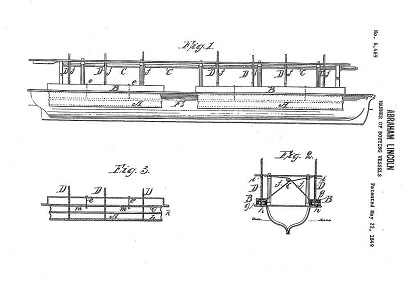
Lincoln recruited a mechanic in Springfield to make a model of the patent so he could test the feasibility of the transportation technology. But the technology was never to be realized. Politics proceeded to take over Lincolns priorities.
William H. Herndon, a law partner of Lincoln’s at the time, had his doubts about the device. He has been quoted saying:
“Occasionally he would bring the model into the office, and while whittling on it would descant on its merits and the revolution it was destined to work in steamboat navigation. Although I regarded the thing as impracticable, I said nothing, probably out of respect for Lincoln’s well-known reputation as a boatman.”
Works Cited
“Abraham Lincoln's Patent.” Wikipedia, Wikimedia Foundation, 4 May 2019, en.wikipedia.org/wiki/Abraham_Lincoln's_patent#Lincoln's_reflections_on_patents.
Edwards, Owen. “Abraham Lincoln Is the Only President Ever to Have a Patent.” Smithsonian.com, Smithsonian Institution, 1 Oct. 2006, www.smithsonianmag.com/history/abraham-lincoln-only-president-have-patent-131184751/.
- Details
- Written by: Quintus Potgieter
The offshore oil and gas industry is an industry well known for its high risk nature. Not only are the employees who work on the rigs putting their lives in danger, but so are the employees who work under it. These employees are the oil rigs’ deep sea saturation divers. They have one of the most dangerous jobs in the world, walking on the bottom of the ocean floor.
Deep sea diving operations are important to offshore oil and gas operations around the world. Engineers need them for oil well checks and changes, installation of new wells and decommissioning of old ones.
Humans are utilized when diving up to depths of 200 meters. For anything past those points, specially engineered vehicles are required. These divers are subjected to ten times the atmospheric pressure humans experience every day.
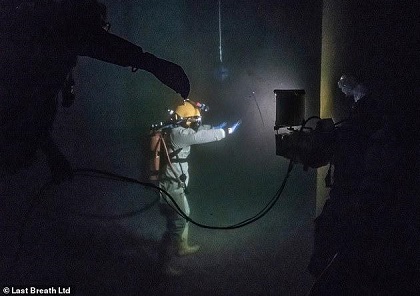
The dive support vessels are built around a pressurized saturation system. On the vessel itself, specialized living chambers are set up for the divers to sleep in. The vessel houses smaller vessels called “Bells’ that take the divers down to the seabed. Divers are lowered into the sea, tethered to the ship above. The divers essentially live underneath the ocean for 28 days.
When living on the Bell, divers breathe a helium-oxygen mixture (named Heliox) to prevent nitrogen narcosis, which makes the crew’s voices go high pitched just like the effects of breathing in air from a helium balloon. The divers say living underneath the ocean is just like living on the International Space Station, just under water.
A computer system is run in a mode named Dynamic Positioning mode that locks the vessel over the exact point on the seabed. They then lower the Bell down from the ship in the exact location and the engineers dive from the Bell into the ocean.
Engineers facilitate the functioning of all the important on-board computers. A Dive Supporter, who sits within the vessel atop the sea, also monitors all of the divers in real-time underneath the ocean. Cameras track their every move.
Inside the Bell, there is a man who does not dive down, but rather regulates the gases of the divers and the feeding of the ‘umbilical cord’ that tethers the divers to the Bell under the ocean. The umbilical cord feeds hot water into the diving suit to keep the diver warm, and provides gas to breath - while being the physical tether to the boat.
Last Breath
Saturation diving has become the subject of a new BBC documentary that has made its way to Netflix named ‘Last Breath’. It follows the true story Chris Lemons, a saturation diver who was deployed to the middle of the North Sea to dive down and perform some changes to an oil well there. In September of 2012, the dive support vessel Lemons was on was traversing the North Sea Oil Fields, 127 miles east of Aberdeen.
On the 18th of September 2012, Lemons was at the bottom of the North Sea, but little did he know that a storm was brewing above the water. The storm was so powerful that it knocked out and overrode the GPS systems on the vessel, leaving it to float away from the location the divers were doing their maintenance at. It resulted in Chris Lemons’ umbilical cord being severed. He only had five minutes of oxygen left in a reserve tank on his back.
The crew was unable to get the vessel under control and find Lemons as the storm threw the ship off course. Once they had managed to get the ship’s automated control systems rebooted it returned to its previous GPS locations, however more than a quarter of an hour had passed. They eventually managed to track Lemons down, he was assumed dead. But after Bellman Duncan Allcock performed CPR, Lemons was resuscitated.
Chris Lemons was without oxygen for 33 of the 38 minutes he was under the ocean for. Experts are still trying to explain how he survived. The documentary is definitely a must-see for engineering enthusiasts and those who want to see a truly miraculous story of survival.
Works Cited
“Last Breath.” Netflix, 6 May 2019, www.netflix.com/watch/80215139?trackId=13752289&tctx=0,0,918ad4a9fe2b7784d8c79439f0ec1e1c83f2fc41:4f43e0538969a387426f5910f8d43f377769aa91,.
Peter Stanford For The Daily Mail. “How Did a British Diver Stranded 300ft under Sea Survive with NO Oxygen for 38 Minutes? .” Daily Mail Online, Associated Newspapers, 10 May 2019, www.dailymail.co.uk/news/article-7013143/How-did-British-diver-stranded-300ft-sea-survive-NO-oxygen-38-minutes.html.
- Details
- Written by: Quintus Potgieter
Huawei. You have probably heard of them - you may even own one of their smartphones. They are the second largest multinational technology company in the world, coming second only to Samsung. With the enormous size of the company, and tremendous force of national pride in China, there are thousands of engineers working for them around the world.
Huawei have been instrumental in implementing mobile internet technology infrastructure in many countries across the world, making them the world’s biggest supplier of networking technologies. However, U.S. intelligence figures are beginning to suggest that Huawei’s technology is being used to spy on its users on behalf of the Chinese government, a controversial finding when thinking of the growing trade war between China and the American government under the Trump administration.

The US and China’s escalating trade war took a recent turn on the 17 May 2019. The Trump administration signed an executive order that drew a line in the sand of the tech world. Businesses are now banned from buying Huawei networking equipment, and Huawei themselves have been blocked from utilizing American companies’ resources for their technology. Huawei had effectively been blacklisted on the US market.
One of the biggest problems on the consumer level was clear: smartphones need Google. Google is the home of the Android operating system and the owner of many online resources accessed by people all over the world. As a result of the executive order, Google had to revoke the licensing granted to Huawei to utilize the Android operating system.
Huawei’s past and present devices were issued a ninety day exemption that would see the Huawei devices getting updates from Google. Once the ninety days are over, Android upgrades would not be available for those devices. The blacklisting will also leave the phones unable to use Google Play Services. Apps like Gmail, YouTube, and the Google Play Store, rely on Google Play Services to function.
If the blacklisting continues, Huawei will need to build their own app store to be implemented in their smartphones. But software aside, it’s the engineered hardware that Huawei might lose out on if this ban continues.
A global technology dilemma
The problem Huawei faces is that they need U.S. components to build their smartphones if they want to keep manufacturing them at the pace they usually do.
UK-based (with American origins) chip designer ARM was directed to halt ‘all active contracts, supporting entitlements, and any pending engagements’ with Huawei. ARM produces vital mobile devices processors, so if the blacklisting continues, Huawei might need to find a new provider for its processors or even start developing their own.
Huawei seemingly foresaw the ban and stockpiled troves of chips and vital components to keep the business producing technology while the uncertainty grows. Huawei may be hoping that the blacklisting is revoked before they run out of the components, because manufacturing without American components will pose a whole new set of problems for the company.
The blacklisting will also slow the rollout of global 5G, which Huawei was busy with globally before the controversy. Huawei had seemingly been pushing forward faster than the United States at their rollout of 5G technologies, which also could have aggravated the trade war.
The trade war further highlights how engineers are caught in the middle of political escapades. The blacklisting affects many different companies across the globe, and impacts those who work for them.
Huawei, however, remains optimistic that this will all be wrapped up in due time. They said:
“We value our close relationships with our partners, but recognize the pressure some of them are under, as a result of politically motivated decisions. We are confident this regrettable situation can be resolved and our priority remains to continue to deliver world-class technology and products to our customers around the world.”
Works Cited
“Google Pulls Huawei's License for Android, Apps After US Blacklisting.” Interesting Engineering, 20 May 2019, interestingengineering.com/google-pulls-huaweis-license-for-android-apps-after-us-blacklisting.
Lee, Dave. “Huawei: ARM Memo Tells Staff to Stop Working with China's Tech Giant.” BBC News, BBC, 22 May 2019, www.bbc.com/news/technology-48363772.
- Details
- Written by: Quintus Potgieter
Engineering and politics are intricately linked. The prioritization of certain engineering disciplines and technologies may depend on where leading political parties lie on the political spectrum.
In the United States, the Democrats were not supportive of the construction of a new phase of the Keystone Pipeline (an oil pipeline system between Canada and the United States), whereas the Republicans were practically racing to get it built. When Donald Trump won the Presidential Election, the hurdles that were keeping the Keystone construction back, were effectively cleared.
Climate change, and the engineering technologies that cause the phenomena, have been heavily politicized - which left-leaning parties have been using to try and sway voters with.

A similar situation recently played out in Australia. Two years ago, Australia’s then Treasurer Scott Morrison taunted the Opposition by carrying a lump of coal into the House of Representatives. It was to mock what they were saying were Labor’s hasty plans to move away from fossil fuels, which they said would result in thousands of job losses.
Scott Morrison is today the Prime Minister of Australia. He emerged victorious in the 18 May 2019 election, in what he described as a ‘miracle’ victory. The industries that are invested in coal, have welcomed the appointment.
Minerals Council of Australia (MCA) CEO, Tania Constable, told media:
“The Coalition government’s strategic economic reform agenda to keep taxes low, in conjunction with responsible 2019/20 Budget measures, provides opportunities for large and small business to be successful. It also means that the mining industry will continue to develop the nation’s minerals for the benefit of everyone. This is a win for regional jobs, particularly in the big resources states of Queensland, New South Wales and Western Australia. There is now a clear mandate for resources projects that have lawful approvals to proceed, such as the Adani coal mine in central Queensland and the Yeelirrie uranium mine in Western Australia.”
Adani Group has seen a lengthy delay on their mega coal mine in the north of the Galilee Basin in Central Queensland. They are seeking to generate 60 million tonnes of coal per year, with a total capacity of 2.3 billion tonnes over 60 years. It is expected to be the largest coal mine in Australia and one of the largest in the world.
On a federal level in the election, the people of Queensland seemingly voted in favor of the Coalition government, which to engineering bodies and the Adani Group specifically pointed to the fact that they think the coal mine should go forward. Appealing to jobs seemingly worked handsomely. Lucas Dow, Adani Australia Chief Executive Officer said in a Twitter video after the election results:
“When there is an opportunity like the Carmichael Project ready to deliver thousands of jobs today in a manner that is both commercially and environmentally responsible, people cannot fathom why the Queensland Labor government refuses to get behind the Carmichael Project.”
The Adani Group had its eye on getting the ball rolling on the mine in 2010. It took a couple years to grow legs, and by 2017 the regional headquarters of the mine were opened and the promise of construction was on the way. It was only in November 2018, that any indication the mine might be finished started to show. Soon after, it became an environmental bone of contention on the lead up to the election.
From the affect the coal mine will have on the climate, to the endangerment of the black-throated finch bird population, were among the issues being hurled at the Adani Group’s impending mine. There have also been protests under a movement known as #StopAdani.
Despite the national election results, voters were resolute in their intention to vote against the alleged climate denying politicians - most notably in Warringah. Exit polling in Warringah, where Tony Abbot from the Liberal Party was unseated by Independent Zali Stegall, indicated that climate change was voters’ top issue.
Thus, it seems like it will not be plain sailing for Prime Minister Scott Morrison as opposition parties and groups seek to continue to oppose the leading government on the topic of climate change. However, regional miners and engineers in the line of benefitting from a coal-friendly Prime Minister are welcoming the election results.
Works Cited
Cave, Damien. “It Was Supposed to Be Australia's Climate Change Election. What Happened?” The New York Times, The New York Times, 19 May 2019, www.nytimes.com/2019/05/19/world/australia/election-climate-change.html.
Karp, Paul. “After the Climate Election: Shellshocked Green Groups Remain Resolute.” The Guardian, Guardian News and Media, 19 May 2019, www.theguardian.com/australia-news/2019/may/20/after-the-climate-election-shellshocked-green-groups-remain-resolute.
- Details
- Written by: Quintus Potgieter
We are only five months into 2019 and America has already seen 693 tornadoes tear across their sky. Just over the last couple of weeks, the American Midwest has been battered by over 100 tornadoes that have left several states with billions of dollars of damage to recover from. And so, with many buildings left destroyed, civil engineering is quick to come to into action.
The immediate concern when any storm hits is flash flooding. Over the last 12 days Oklahoma has witnessed rivers and dams rise to levels that have never been seen before.
Their streets were flooded due to drainage systems being overloaded and the natural earth simply not being able to absorb the amount of water falling from the sky. However what follows the flash flooding is far more worrying. When the sky turns an eerie shade of green, Americans known all too well what follows…a tornado.
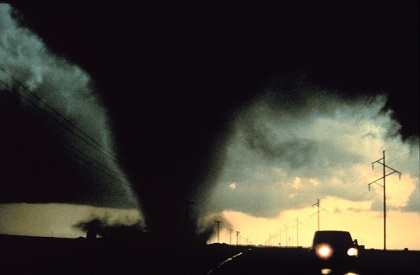
Last Wednesday, late in the evening of 24 May, a maximum strength EF3 tornado touched down in Jefferson City, Missouri. Tearing across 32 miles of country, the tornado resulted in immense amounts of heavy damage. Dr Giuron (Grace) Yan, a Missouri S&T assistant and professor of structural engineering, made a trip to Jefferson City to study the destroyed structures, and their structural integrity after the tornado
Yan currently operates a wind hazards laboratory named the WHAM lab at Missouri University of Science and Technology. Sending a number of drones into the sky, Yan and her team were able to assess the damage left behind in the wake of the storm, observing some houses with their roofs completed taken off but some with only partial damage.
Yan will be using the data gathered for research purposes in hopes that her and her team can develop guidelines for tornado-resist construction. The ultimate goal would be to have these guidelines standardized and used to improve the official building codes in the area.
She notes that the extensive damange is due to the municipal building codes for residents not enforcing a rule that homes must be able to withstand rotating winds. She says some homes in Jefferson City are only built with ‘straight-winds’ in mind. She is thus planning to recommend the municipality implement residential building codes that will force residents to build with more than just thunderstorms in mind. Yan told STL Public Radio:
“If the tornado intensity is not that high, and if we have improved our building code to recommend tornado-resistant design, the damage would be much less. For example, a number of buildings, the entire roof has been blown off but if we performed tornado-resistant design, the damage can be minimized to just the shingles.”
The civil engineering lessons Yan and her team are learning are useful. Yan points out that the Missouri State Penitentiary didn’t withstand the force of the tornado but just across the road, a house seems virtually untouched. Residents of the town are in awe of the tornado, effortlessly carrying away blocks of concrete with the wind.
The research is important, especially when considering that in the future it could save lives when future tornadoes hit. Unfortunately, some damaged buildings in the wake of tornadoes can never be repaired, and some lives are ultimately lost. Nonetheless, Americans are resilient, and their rebuilding spirit has kicked in, in a country that has seen this carnage many times before.
Works Cited
Chen, Eli. “Missouri S&T Engineers Inspect Jefferson City Tornado Damage To Make Houses Stronger.” St. Louis Public Radio, news.stlpublicradio.org/post/missouri-st-engineers-inspect-jefferson-city-tornado-damage-make-houses-stronger#stream/0.
Ktul. “UPDATE: Officials Pull Back on Water Release from Keystone Dam.” KTUL, 29 May 2019, ktul.com/news/local/keystone-release-could-be-dropping-as-resilient-community-fights-back-flood-water.
- Details
- Written by: Quintus Potgieter
In the 1800s the United States was industrializing to the point where New York and San Francisco, states that were quite literally on opposite sides of the country, needed to figure out a central point at which they could trade with each other. They would, via their respective railroads, meet in the middle at a trading port in New Orleans. However a lake stood in their way, Louisiana’s Lake Pontchartrain.
The railway, at over nine kilometres long, is the longest railway crossing over water on earth and the longest railroad bridge in the United States. Engineers completed the bridge over 130 years ago. Back then, it was entirely made of wood. Now it is a concrete ballast deck bridge.
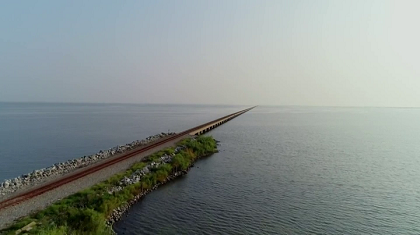
The bridge provides a pathway into New Orleans and is still to this day a vital piece of infrastructure for the trading of goods within the United States.
However, with a low lying concrete deck bridge comes a problem; boats can not pass underneath the bridge. In solution to the issue, engineer William Donald Scherzer came up with the idea of the rolling bascule bridge. A 66 meter long Scherzer bridge fitted to the railway raises the span by rolling on a track with a 830-tonne counterweight that takes the bridge skyward.
Patrick Weldon, an Assistant Division Engineer of Bridges on the Norfolk Southern Railway, talking to the television programme Impossible Engineering, explained:
“We have machinery at the top of the bridge that is powered by two electric drive motors. There are two pinions and those pinions rotate across a rack system. Essentially what happens is, it applies force to open the bridge.”
In 2005, the bridge was put through its biggest challenge yet; Hurricane Katrina. It led to the damaging of 7.5 kilometers of railway was swept off the bridge and into the bottom of the lake. Maintenance teams had to use cranes to pull the railway back onto the bridge deck. Only 16 days after Katrina made landfall, the engineers managed to get train services restored
India’s engineering marvel
At the end of 2018, Indiaopened their latest dazzling marvel of engineering; the longest combined rail and road bridge. It is named the Bogibeel Bridge. It crosses over the River Brahmaputra, sitting between the Dibrugarh and Dhemaji districts of the northeastern state of Assam. The bridge stretches to a length of 4.94 kilometers.
It has been a long process from laying the foundation stone of the bridge in 1997 until its operation in 2019. The bridge was delayed due to a plethora of issues, ranging from lacking the appropriate technology, subsequently missing deadlines as a result, and the rising costs of construction.

Engineers have essentially changed the lives of the people of Dhemaji with the construction of the bridge. The bridge has provided easy access to hospitals, education institutes and the Dibrugarh airport. The railway also bypasses 705 kilometersthat passengers would have had to endeavour before the bridge’s construction.
When all the delays were figured out, the bridge’s construction went ahead. Standing atop 42 pillars which were constructed using state-of-the-art Germany engineering technology, the bridge was welded together. The welding of the bridge has ensured it is significantly lightweight when compared to riveted girders. Engineers also had to account for the rising of the Brahmaputra river which swells during rainy seasons. Consequently, they built the bridge 32 meters above the river water level.
The bridge has a lifespan of 120 years, and is the second longest bridge in Asia. And now, it is the darling and pride of India.
Works Cited
“‘Impossible Engineering’ Beasts of the Bayou.” IMDb, IMDb.com, 1 May 2019, www.imdb.com/title/tt10121906/?ref_=ttep_ep1.
“All You Need to Know about Assam's Bogibeel Bridge - How Special Is the Bogibeel Bridge.” The Economic Times, economictimes.indiatimes.com/news/politics-and-nation/all-you-need-to-know-about-the-bogibeel-bridge/good-governance-day/slideshow/67241699.cms.
- Details
- Written by: Quintus Potgieter
Wireless charging technology has had a serious hit or miss relationship with the mobile industry. With some standards being cleared, some technology being engineered and some being still stuck in pre-production, it’s hard to know what’s going on sometimes. However new developments might mean we are closer than we think.
Qi is the charging standard that defines wireless power transfer using inductive charging methods. The increasing development of this technology has gotten engineers minds inventing at a million miles an hour. If smartphones will be able to charge their batteries without the need for wires, what else could be charged wirelessly too?

In 2016, a company named Texas Instruments, who specialize in wireless technologies, began experimenting outside the smartphone and branching out to other industries. They released the industry’s first Qi-certified 15-W wireless power transmitter.
“Industrial equipment such as electronic point-of-sale devices and handheld medical equipment reap the benefits of 15-W wireless power. This breakthrough in technology enables wireless models and reduces overall end-application size by helping eliminate bulky wiring.”
However the smartphone industry is still leading the way in the wireless charging revolution. There are rumors currently circulating that the next generation of iPhones will employ what is called bilateral charging. This form of wireless charging allows one charged up phone to transfer some of its battery power to another device that requires charging.
Electronic Vehicles
Electric vehicles (EV) are another industry where wireless charging could revolutionize the technology used. However, whilst the industry has taken many leaps forward; EVs are still stuck in the development phase.
The company Qualcomm develops wireless charging technology for electric vehicles under the name HALO and has subsequently just sold their technology off to MIT-founded business WiTriCity. WiTriCity has now started the process of formalizing a wireless charging standard for automakers. Their aim is to make ‘EV charging easier than refueling’.
They are working on park-and-charge bays and power transfer grid-to-battery technologies that would charge cars through surface or in-ground placements placed in asphalt, cement and more.
Encouragingly for WiTriCity, the joint venture with Qualcomm gives them access to incredible patents and pending patent applications.. Now the companies can work to improve the technologies and could lead to some breakthroughs for electric vehicles.
Alex Gruzen, CEO of WiTriCity, in a press statement, wrote:
“WiTriCity’s wireless charging technology is key to the future of mobility which is clearly electric, and is increasingly shared and autonomous.”
Qualcomm’s HALO technology has also been embedded into an electric vehicle charging road. The road was also a joint venture - this time, with automaker Renault. Their tests saw an electric vehicle being charged at 20kW while travelling 100km/h.
Robert Lassartesses from Renault said:
“If you compare fast charging with gasoline, it’s not equivalent. Even in our best dreams [EV charging] is 300kW. We are 20 times below what you can do with gasoline and it’s important to keep this in mind. Equivalent service between electricity and [traditional] fuel cannot be expected.”
300kW could be attainable with an 800V battery, the experts said, but the battery would be far too heavy. Thus, the development of batteries, and their wireless charging applications, is ongoing across engineering industries. The benefit for the consumer is clear: batteries that last longer and go further.
Works Cited
“TI Announces the Only Qi-Certified 15-W Wireless Power Transmitter.” News, news.ti.com/ti-announces-only-qi-certified-15-w-wireless-power-transmitter.
Ward-Foxton, Sally. “'Electronic Road' Charging For EVs Moves Forward.” EETimes, EE Times, 23 May 2017, www.eetimes.com/document.asp?doc_id=1331778.
- Details
- Written by: Quintus Potgieter
Nokia wants to show the world what is possible with 5G networks and automated factories. Not only is the company now manufacturing mobile technologies with 5G embedded within their architecture, but they are also using it to automate their factories.
Based in the Finnish city of Oulu, Nokia has built a factor which they consider to be the future of modern industrial production and manufacturing. Whilst the plant has always belonged to Nokia, the company has now retrofitted the plant with new llot-powered technologies.
Nokia wanted to make a factory that was “conscious”, a self-thinking and always learning factory of the future. 5G, in general, will transform engineering industries; industries that have been trying to take the workforce out of harm's way by replacing repetitive tasks in industrial operations.
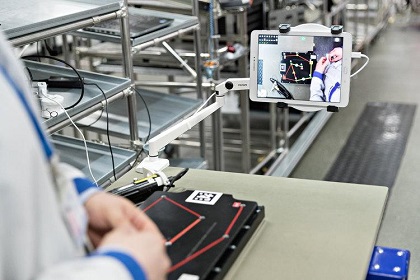
President and Chief Executive Officer of the Nokia Corporation, Rajeev Suri said:
“It possesses unique characteristics that make it socially and economically transformative: low latency (in other words, almost imperceptible lag when carrying out remote orders); fast speeds (around 10 times faster than today’s networks); connection capability (enabling up to 1 million linked devices per square kilometer); and unparalleled reliability (allowing new precision-based applications).”
To show how the lower latencies work with 5G, Nokia tested advanced real time quality control with their 5G system powered by Intel. The engineers intentionally made errors in a manufacturing process, which the 5G monitoring system with a camera attached to it flagged the error immediately, suggesting course corrections for the process. See it in action here:
Nokia is incorporating the characteristics of ‘flexibility, versatility and productivity’ into the factory. They are also processing all of the data generated by the factory in the cloud. Suri writes:
“The vast majority of the factory is now automated. Its temperature and humidity automatically change to keep machines in prime condition. Parts are delivered using autonomous vehicles. Equipment carries indoor GPS, allowing managers to see exactly where it is, what it’s doing and whether it could be used or positioned more efficiently.”
Nokia does not only believe that the adoption of 5G is good only for manufacturing plants, they believe it will transform all humans’ lives. The factory itself has worked well on their 4G network, proving that many companies can start with the technology already available to companies around the world. But 5G is the next frontier. Suri writes:
“This is only a first step. More are necessary. Governments in particular need to step on the gas and prioritize 5G adoptions. But if ever something was worth working for, it’s this. I firmly believe that the sooner governments, businesses and individuals have access to 5G, the sooner the Fourth Industrial Revolution can help people all over the world enjoy safer, happier, more productive lives.”
Works Cited
“Industry 4.0 Use Case over 5G at Nokia Oulu Factory.” Nokia, www.nokia.com/about-us/news/media-library/industry-40-use-case-over-5g-at-nokia-oulu-factory/#1.
Suri, Rajeev, and Nokia Corporation. “5G Will Redefine Entire Business Models. Here's How.” World Economic Forum, www.weforum.org/agenda/2019/01/5g-will-redefine-entire-business-models-here-s-how/.
- Details
- Written by: Quintus Potgieter
It was a story of ineptitude, willful ignorance, and oncoming catastrophe. But that didn’t stop civil engineers in the state of California from bouncing back and rectifying what had been neglected. In February 2017, Oroville Dam’s main and emergency spillways were damaged due to heavy rains which exposed the ill maintenance and general corrosion of the main and emergency spillways.
The reservoir is California’s second-largest provider of water. The dam’s capacity is 4.363537 km3, which equates to 1.75 million Olympic swimming pools. During the crisis, more than 190,000 people had to be evacuated from Oroville and the surrounding counties due to fears that the concrete weir of the dam could collapse and send water flooding into the regions.
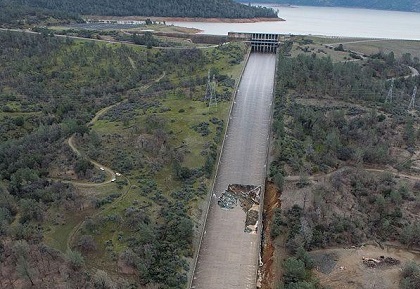
Thankfully, there was no collapse in Oroville, but extensive repairs were needed. The Department of Water Resources’ engineers went to work and began a repair project that would see some impressive work done. On the 2nd of April 2019, it opened for the first time after the crisis.
The repair
On the main spillway, every 5 minutes, a dump truck would place 19 cubic meters of roller-compacted concrete onto the main spillway. They would eventually lay over 100 thousand cubic meters of concrete for the repair of both spillways. They utilized 16,000 feet of drainage pipe, which is equivalent to 500 Olympic swimming pools. And to keep everything in place? Five million kilograms of reinforcing steel.
The engineers constructed a secant wall out of reinforced concrete piles for the emergency spillway. The wall, in length, was just four feet shorter than the height of the Empire State Building.
It was initially thought that the repair work would only cost $400 million USD, but the final number was much larger. The final repair bill weighed in at $1.1 billion USD. Speaking to the Sacramento Bee, Joel Ledesma, the deputy director of the California Department of Water Resources said:
“We are prepared; we’ve spent the last two years restoring full functionality. The industry has learned a lot since this dam was built 50 years ago.”
They reopened the spillway and began pushing water at 3,300 cubic feet per second down the newly repaired spillway on its first day of operation.
Joel also told the media that the new spillway was ‘designed and constructed using 21st century engineering practices and under the oversight and guidance from state and federal regulators and independent experts’. Below, is a video that shows the rebuilding process:
Works Cited
Caraccio, David. “Enough Concrete to Pave from Oroville to Texas, and Other Facts about Oroville Dam Repair.” Sacbee, The Sacramento Bee, 5 Apr. 2019, www.sacbee.com/news/state/california/article228890254.html.
Pedroncelli, Rich, et al. “$1.1B Oroville Dam Spillway Repairs Put to Test.” Construction Equipment Guide, Construction Equipment Guide, 10 Apr. 2019, www.constructionequipmentguide.com/11b-oroville-dam-spillway-repairs-put-to-test/44557.
- Details
- Written by: Quintus Potgieter
Roads are something we use every day. Whether it’s for going to work, school or anything in-between, the quality infrastructure of roads are detrimental to our safety. So what do you do when they start to fall apart?
Road infrastructure in Johannesburg, South Africa, is currently under threat. 94% of bridges are in just fair to extremely poor condition meaning out of 902 bridges, only 6% are acceptable. 707 bridges are categorized as poor to very poor in terms of structural integrity. These statistics were released by the Johannesburg Roads Agency (JRA) and Mayor of Johannesburg Herman Mashaba.
Mashaba spoke to Carte Blanche about the bridges, saying:
“You drive over them or underneath them at your own risk. It is a scary situation. I have engineers on a regular basis that go and look at the condition [of the bridges]. Where am I going to get 6 and half billion Rand to fix them overnight?”
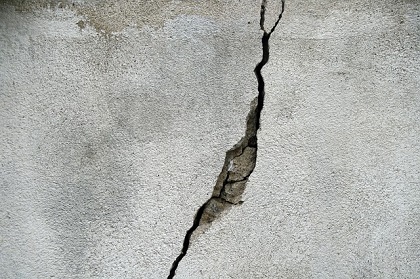
In 2018, there was an emergency sectional closure of the M2 Selby Bridge to prevent further stress on the aging infrastructure. However the diverted traffic is now crossing over bridges which, according to local engineering experts, are also structurally unsound.
Unfortunately, Johannesburg’s government is lacking the resources to upgrade the quality of the roads. Mashaba blames the previous government of the city - that government being the ANC. Now, Johannesburg has been taken over by the Democratic Alliance and they sit with the maintenance shortfalls.
The JRA says that the rise in population and developments in the city has caused more traffic, which in the long term has adverse effects on bridges. The JRA also reported that some bridges had even reached the end of their design lifespan.
And it doesn’t stop there. Unfortunately, for the safety of the people of Johannesburg, there is proven corruption within the Johannesburg Roads Agency. The tender process that is supposed to delegate the task of repairing bridges with monetary compensation to construction contractors is being done irregularly. Consequently, there is a bottlenecking of the maintenance and repair of bridges. The bridges could be ticking time bombs if more rain is expected - Johannesburg's city transport department confirmed that 37 bridges had collapsed during storms since 2013.
Equally perturbing is the fact that the JRA has not released to the media or the public a list of bridges that need urgent attention however it is evident that at least some work is being done. On the 25th March 2019 a R6-million (about $424,000 USD) project saw rehabilitated roads opened in Ivory Park near Midrand. This has included underground storm water management systems to ensure a longer life span for the bridges.
With slow maintenance and repairs, the chances of loss of life from potential collapses grow with every hour that goes by. The hope is that the right companies with the right civil engineers get contracted to maintain and repair the many bridges that need serious attention in Johannesburg.
Works Cited
Arnoldi, Marleny. “JRA Completes Two Ivory Park Road Upgrades, More to Follow.” Engineering News, www.engineeringnews.co.za/article/jra-completes-two-ivory-park-road-upgrades-more-to-follow-2019-03-25.
“Fraud and Corruption Inside the Johannesburg Roads Agency | Carte Blanche | M-Net.” YouTube, 2 Apr. 2019, youtu.be/36usxDDZGIA.
Tonisi, Lelethu. “Structural Decay: Crumbling Bridges: M2 Closure Adds to Joburg Commuter Stress.” Daily Maverick, Daily Maverick, 14 Mar. 2019, www.dailymaverick.co.za/article/2019-03-14-crumbling-bridges-m2-closure-adds-to-joburg-commuter-stress/.
- Details
- Written by: Quintus Potgieter
As the world begins to demand increasingly sustainable and renewable methods of power, engineers are having to rise to the challenge to change the routines of established industries that have been operating the same way for hundreds of years.
Some of the oldest trades in the world which have constantly evolved to keep up with newer engineering technologies are eagerly looking to cut down on the amount of emissions they produce.
One of those trades is the art of cheese making.
If you had told a farmer hundreds of years ago as they drained their whey from curds that cheese would be made by renewable engineering technology, they definitely would not have believed you. In the United Kingdom, the first carbon neutral cheese makers are doing just that.
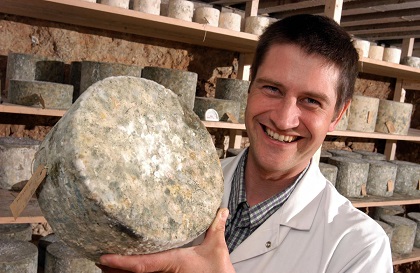
Robin Betts runs Winterdale CheeseMakers in the United Kingdom. The Betts family has been making cheese for over 500 years. If only his ancestors could see the farm now!
Robin explained how the farm’s setup works to website Inverse:
“The great thing about Winterdale is that we use all our own milk from our family farm - but its warm...that’s the crucial thing. And that means, we don’t use any energy whatsoever to start the cheese making. So in the whole cheese-making day, we just need a bit of energy. So what we did to achieve our neutral carbon status was to install solar panels and a ground source heat pump.”
Taking milk straight from the cows to the cheesery also cuts the percentages of energy Winterdale uses, per cheese making effort.

Not only is the cheese made with clean energy, the cheese is also delivered carbon neutrally. Robin charges his Tesla Model X with the solar panels on the roof of the cheesery and then delivers the cheese to London without generating any carbon footprint.
It all makes financial sense for Robin and his team of cheesemakers to keep operations running with renewable energy and he isn’t finished innovating and transforming his farm just yet. He has just unveiled a six-kilowatt wind turbine that will generate even more energy.
To capture the wind energy from the turbine and the solar energy from his panels, he is now utilizing three Tesla Powerwall batteries. Thus, he can power his operations in the morning, noon, and night. There are of course some days that Robin has to pull energy from the grid when the sun is not shining, and the wind is not blowing.
However, Robin says the factory majority of the time is carbon neutral, and that is a success. With the renewable delivery of the cheese, Robin is leading and pioneering a way forward for other farmers out there. Thanks to the engineering of new energy technologies, running a diary and making cheese can become a zero emissions industry.
Works Cited
Brown, Mike. “Tesla Batteries Power This 500-Year-Old Cheese Farm.” Inverse, www.inverse.com/article/54291-winterdale-cheese-farm-tesla-batteries.
“Winterdale Cheesemakers.” Facebook, www.facebook.com/winterdalekent/.
- Details
- Written by: Quintus Potgieter
Plagiarism is any creative industry is an incessant problem, allowing people to get away with ideas that are not rightfully theirs. This is particularly evident in China, who is notorious for their knockoffs of products from around the world. However a landmark victory in a recent court case might be changing that as China’s engineering industry is put under the spotlight.
Jaguar Land Rover (JLR) celebrated the victory which is being called a ‘first’ for the global car industry in which they made claims against a Chinese automaker inside a Chinese court and won.
It all started when JLR sued Jiangling Motors Corp in 2016. The Chinese automaker has just released a car named the Landwind X7. It seemed to look eerily similar to JLR’s Evoque.
JLR charged the company with lifting their intellectual property. The Beijing Chaoyang District Court ruled that the side-body design, window outlines, and front and rear lights were all lifted and copied by Jianling Motors.

JLR said in a statement: “We welcome this decision of the Beijing court, which further strengthens our confidence in investing in China and in the fairness of intellectual property adjudication in the Chinese courts. This ruling is a clear sign of the law being implemented appropriately to protect consumers and uphold their rights so that they are not confused or misled, whilst protecting business investment in design and innovation.”
The court ordered all production of the Landwind to stop effective immediately.
However, not all engineers who see their work copied are as successful in stopping or have the means to stop the copycat engineering when they see it arise.
A multi-industry problem
The Verge reports that counterfeit products cost United States’ businesses at least $600 billion USD in 2017. They spoke to the founder of a tech company that launched a self-titled product named ‘Pressy’.
Pressy was a device that would plug into the headphone jack of most smartphones and send command signals to the phone on the press of a button.
When choosing to fundraise through crowdsourcing platform Kickstarter, the founders of Pressy could not have anticipated that they could be opening themselves up to copycats who were ready to steal their idea.
Suddenly, the engineers behind Pressy began to see a Chinese website use images of their product and begin a crowdfunding campaign of their own for the same product. That product turned out to be an exact copy of the Pressy technology that Nimrod Back, CEO and Co-Founder of Pressy invented.

The Chinese copycat fundraiser campaign reached its goal and beat the initial inventors of Pressy to the market with an idea that was originally theirs. Another Chinese company bought the Chinese copycat company and turned his version of ‘Pressy’ into a mainstream item in the smartphone market in China.
Soon after, major smart technology company Xiaomi released their own Pressy-like button. Upon further inspection, the inventors of Pressy discovered that the phone manufacturer was using the exact factory the founders of Pressy did, and were making a knock-off on the same machines that had been earmarked for the production of Pressy.
The idea of suing a company as large as Xiaomi was just not economically viable for a company as small as Pressy. The engineers chose to move on and sell as many of their own version as they could.
Specialist advisory companies are now rising up to help engineers and the like protect their assets from being exploited by copycats. Dragon Innovation is one of those companies. Scott Miller the CEO and co-founder of Dragon Innovation spoke to the Verge. He said that a product is made up of three components that each have their own vulnerabilities. He says these components are ‘electrical, mechanical, and software’.
“Mechanical is really tough to protect. Anybody with a laser scanner can basically recreate in CAT pretty quickly. Electrical is a little harder to protect. But, if somebody is motivated they can actually take an X-ray machine and X-ray all your traces and be able to re-create the printed circuit board or figure out what components you have selected even if you wipe off the silkscreen.”
“And then the third system, software, is the one that I always choose to protect because, in some ways, it’s the easiest to rip off if you can copy it, but it is also where most of the IP [intellectual property] lives.”
Engineers are encouraged to take out design patents on products they engineer as a form of protection against copycats. However, chasing copycats with the law is an expensive endeavor. Engineers are consequently encouraged to get as close to launch as possible without publishing the details of their product.
Works Cited
Davies, Rob. “Jaguar Wins Landmark Case against Chinese Copy of Evoque Model.” The Guardian, Guardian News and Media, 22 Mar. 2019, www.theguardian.com/business/2019/mar/22/jaguar-land-rover-wins-landmark-case-against-chinese-evoque-copycat.
“A Gadget Maker's Worst Nightmare...” YouTube, 2 Apr. 2019, youtu.be/7m2K9f6vjgU.
- Details
- Written by: Quintus Potgieter
It survived the French Revolution and two world wars. The landmark is part of Paris’ soul, embodying the city’s history and partially shaping its identity through its religious and architectural significance. The Notre Dame de Paris, a jewel in the French crown, and a marvel of civil engineering, has suffered extensive damage due to fire.
The stunning monument has stood for over 850 years, which made watching it go up in flames so quickly on live television all the more devastating. It has seen much of Paris’ story unfold; the coronations of both Henry IV of England in 1431 and Napoleon Bonaparte in 1804 took place within these walls. Famous French author Victor Hugo set his 1831 classic “The Hunchback of Notre Dame” here — the book is one of the reasons the cathedral got its much needed renovations in the nineteenth century.

Work began on the Notre Dame in 1163, when Pope Alexander III laid the foundation on the ruins of past churches. The structure was not completed until 1345. During that time, the structure underwent four stages of construction. The last sections to be built were the iconic gallery and two towers.
However, the spire that fell during the blaze was not a part of the original medieval work, but instead a result of the nineteenth century restorations. At the same time, the façade we’re all so familiar with was created — 50 years earlier the original exterior was heavily defaced during the French Revolution.
In the current day, it is the most visited monument in the French capital, with 13 million people flocking to see it every year. It is also home to centuries-old relics and artwork.
The conflagration occurred on Monday the 15th of April, shortly after the cathedral had closed for the day. While the official cause is not yet known, experts have speculated the current renovations could be responsible.
The spire, which was the main focus of the US $6.8 million renovation, was ravaged by flames. Contained inside it were relics from the patron saints of Paris; Saint Denis and Saint Genevieve. Two-thirds of the roof and the interior’s wooden structure were also significantly damaged.
Amazingly, French Culture Minister Franck Riester said the significant artworks stored within the cathedral were saved, including the organ, the crown of thorns said to be worn by Jesus, and Saint Louis’ tunic.
Copper sculptures of the Twelve Apostles and four New Testament evangelists had been removed from the spire merely days before the blaze for restoration works. This means they remain unscathed.
The cathedral’s spokesman Andre Finot confirmed the irreplaceable stained-glass rose windows were still intact.
"It's a bit of a miracle. We're very relieved," he told BFMTV.
The famous gargoyles on the outside of the cathedral were a significant feature of the structure. In fact, they were created to drain water of the roof to protect the stone from damage. While they have suffered some damaged, they are believed salvageable.
While standing in front of the still-burning monument, French president Emmanuell Macron told reporters, “Notre Dame is our history, our literature, part of our psyche, the place of all our great events, our epidemics, our wars, our liberations, the epicenter of our lives.
“Let's be proud, because we built this cathedral more than 800 years ago, we've built it and, throughout the centuries, let it grow and improved it. So I solemnly say tonight: we will rebuild it together."
He has since pledged to rebuild the cathedral within five years. However, architectural conservation experts have said it could take triple that time.
Prominent French conservation architect Pierluigi Pericolo said it could take between two and five years just to ensure the structure is stable.
"It's a fundamental step, and very complex, because it's difficult to send workers into a monument whose vaulted ceilings are swollen with water," Pericolo told France-Info.
"The stone can deteriorate when it is exposed to high temperatures and change its mineral composition and fracture inside."
- Details
- Written by: Isabella Foster
Taking a high-rise structure from concept to completion is no easy task — structural and geotechnical engineers usually face an array of design-related challenges. From vulnerability, to seismic activity, to understanding the risks of underlying soils, designing a tall building is a feat within itself.
However, engineers in Kenya can rejoice as The Britam Tower in Nairobi has been named as having the best in mechanical and electrical engineering by The Council on Tall Buildings and Urban Habitat (CTBUH).
The CTBUH recently announced their winners of the Best Tall Building Worldwide and Category Winners at the 16th Annual CTBUH Awards Program, which recognizes projects and individuals that have made significant contributions to the advancement of tall buildings that also achieve sustainability at the highest level.

The Britam Tower, which is the tallest building in Kenya, beat four other projects to the prize, including the Salesforce Tower in San Francisco who won the overall category prize.
Judges were impressed by the buildings rainwater harvesting, ventilation strategies and heat mitigation strategies that save 39 percent on energy bills and 50 percent on water use when compared to the typical high rise building.
“The veil facade solution, consisting of 50 million square ceramic rods in front of a full-height glass curtain wall with selective glass, lets in significantly more light than heat”.
The brains behind the sustainable solutions were chapmanbdsp, an independent design and engineering consultancy based in London. Ian Duncombe, Board Director at chapmanbdsp, accepted the award and said:
“We were up against some really stiff competition...this is a fantastic achievement for the project and for chapmanbdsp in front of our peers on a global stage”.
It’s not the first achievement this Kenyan tower has achieved; it was also the first building in Kenya to receive EDGE (Excellence in Design for Greater Efficiencies) certification, a recognition awarded to building owners who demonstrate a high level of resource efficiency in their buildings.
Working with Gapp Architects, chapmanbdsp engineered a wide variety of solutions within the tower, from powerful solar control to natural ventilation for the office floors. A spokesman for Britam said:
“We are so proud to see our vision realised by the whole team. The work chapmanbdsp did on environmental solutions answered the brief and fully transformed the project”.
“We have been given a legacy we can all be proud of”.
- Details
- Written by: Elyse Simich
Scientists believe if we’re going to combat climate change, we need to electrify all forms of transport. In fact, according to the International Civil Aviation Organization, the demand for air travel by 2050 could increase aviation sector greenhouse gases by 700 per cent compared to emissions in 2005.
As it stands, aviation is responsible for two percent of the world’s carbon emissions. While at cruising altitude, conventional aircraft release nitrogen oxides into the atmosphere, which also have a harmful effect on the environment.
Therefore, it’s critical for engineers to find a way to decarbonize aircraft.
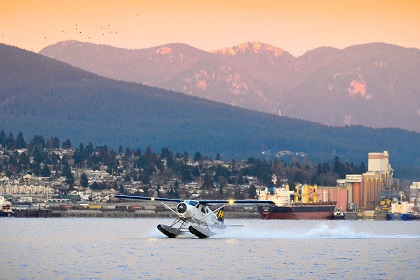
Professor of energy and transport at University College London Andreas Schäfer said, “If you look at the opportunities for reducing aviation CO2 that have been looked at for a long time, then you’re running out of options. The potential for reducing CO2 emissions is not sufficiently strong in comparison to the growth rate of air transport.”
So what are the options? Well, some airlines are experimenting with biofuels, which are theorized to be carbon neutral. However, the cost of using biofuels is high. The other option is electrification.
Last year Norway declared they’re aiming for all domestic travel to be electric by 2040.
In March, Canadian seaplane airline Harbour Air announced they were working with an electric drivetrain manufacturer to retrofit existing aircraft with a battery-electric propulsion system. Harbour Air has a fleet of 42 seaplanes that travel 12 routes. This collaboration with magniX means they expect the first electric flight to take to the skies in 2022.
One of the biggest issues with battery-electric propulsion is the battery life. Currently, the best lithium-ion batteries have a specific energy of 250 watt-hours per kilogram. For aircraft the size of a Boeing 737 or Airbus A320 to travel up to 1100 kilometers, the battery would need a specific energy of 800 watt-hours per kilogram. In comparison, jet fuel has a specific energy of 11,890 watt-hours per kilogram.
One of the reasons Harbour Air is confident they can pull this off is because all of their flights are less than 30 minutes in duration, which means the battery-life limitations aren’t a concern. In fact, the company will significantly cut their costs by making the switch. A regular motor costs between US $300 and $450 per operating hour. The electric motor will cost only US $12.
However, Schäfer estimated that long haul flights won’t be electrified until the middle of the century, given that battery energy densities have been increasing by three to four percent each year.
“It is certainly a long way, but because the time scales of aviation are so long, [airliners] tend to live for 20 to 30 years, we need to start looking at these technologies now so they’re available in 2050,” he said.
Schäfer also said that while hybrid-electric aircraft are a potential stepping stone to fully electric aircraft, they still produce greenhouse gases and rely on cheap, yet powerful batteries.
NASA is building the X-57 Maxwell, the first all-electric X-plane. It features a slightly different design to most propeller-driven planes.
Principle investigator for the X-57 at NASA explains Sean Clarke, “For this scale aircraft, one of the driving design considerations is the landing and takeoff performance. Our wing has the cruise propellers at the wingtip, and that reduces the drag of the wingtip. We also have 12 small propellers that are distributed across the leading edge of the wing. That increases the lift at low speed.”
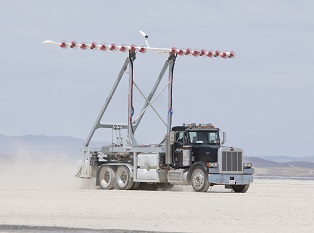
Since take-off and climbing to cruising altitude require a lot of energy and lift, conventional aircraft feature a large wingspan. However, that extra surface area adds drag and makes cruising less efficient. Electric motors are much cheaper and are less mechanically complicated since they don’t require fuel lines, valves and exhaust systems.
The 12 small propellers are switched on allowing the wing to be much smaller than it is on a conventional aircraft. This saves energy during the flight, by reducing drag.
Clarke said electric aircraft could change airline business operations, as the electric motors can allow for almost vertical takeoff and landing, rendering long runways unnecessary.
“There’s a lot of urban air mobility targets where different air framers and operators are advertising a future where you can take an air taxi from somewhere in a metropolitan area to somewhere 10 miles away and fly over all the rush hour traffic,” he said.
“It is really exciting because it’s starting to grow pretty quickly around the technologies that we’re already working with.”
- Details
- Written by: Isabella Foster
Judith Resnik never planned on being an astronaut. Her dreams were initially set on being a professional concert pianist. However, in the end, she was neither. Resnik was an American electrical engineer, software engineer, biomedical engineer, pilot, the first Jewish American in space and the fourth woman in space.
Born in 1949 to Sarah and Marvin, both Jewish immigrants from Ukraine, Resnik grew up in a simple home in Akron, Ohio. Her father was an optometrist and her mother a former legal secretary; however, they would divorce when Resnik was just a teenager.
With a fond crush on Tom Selleck and an infamous halo of dark hair, Resnik excelled at many things throughout her life. An outstanding student, she shone in areas of mathematics, languages and music. She would go on to earn a perfect score in her SAT exams.
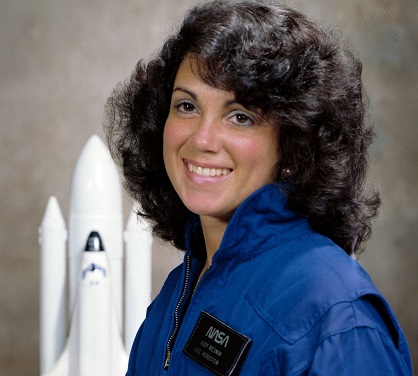
Resnik pursued studies in mathematics at Carnegie Mellon University, only to develop a passion for electrical engineering after attending lectures with her boyfriend at the time. She would earn her B.S. degree in electrical engineering in 1970.
In 1977, NASA began recruiting minorities and women to the space program. Recruitment had skyrocketed at the time as Nichelle Nichols was working on the campaign. Nichols played Nyota Uhura in the Star Trek series.
Resnik had never shown particular interest in joining the space program but if her childhood had given example to anything, it was that Resnik shone at whatever challenge she put her mind to. In 1978, at the tender age of twenty-nine, Resnik was one of only six women chosen to be a part of the NASA program.
In 1986, the tenth flight of Space Shuttle Challenger was set to take off. This would be Resnik's second space launch and she was to assist in photographing Halley’s Comet. The mission was under a particular media spotlight due to the attendance of a civilian crew member, a teacher from New Hampshire.
After six days of delays, January 28 was unusually cold. Hundreds of people who had gathered on the ground to watch the launch huddled together in blankets and layers of clothing. Behind the scenes, the Ice Team had worked exhaustively over the course of the night removing ice which had gathered on the launch pad. Despite weather concerns, pressure rising from the constant delays resulted in a mission clearance, though it was rushed and tightly contested.
Engines ignited at 11:38 a.m. EST but 73 seconds into flight, in front of hundreds of eyes on the ground and millions on television, Challenger broke apart. All seven crew members were killed.
Judith Resnik died in one of the worst space disasters in history at the age of thirty-six.
However, Resnik’s memory deserves to be much more than her association with tragedy.
Resnik embodies the qualities that make a role model. She is now and always will be an example of human bravery, determination and brilliance. With a passion for science and uncovering the unknown, Resnik’s soul found a home in space. Her passion and curiosity impacted every life she touched.
Despite her story being cut short, let Judith Resnik remind us of what we are capable of, and inspire women studying engineering of what is possible. To quote her father,
“She had the brain of a scientist and the heart of a poet”.
Godspeed Judith Resnik, thank you.
- Details
- Written by: Quintus Potgieter
Multinational oil and gas corporation Exxon Mobil is working towards a clean energy future. They are embarking on a process of introducing technology into industrial plants that will make them more sustainable into the future.
A new television advert from the company shows that their engineers and scientists are working towards refining carbon capture technology for industrial plants. By replicating the real process of how plants capture carbon dioxide, they are hoping industrial plants and power stations could do the same.
The World Economic Forum is suggesting that carbon capture ‘could be the game-changer the world needs with investment into clean energy technologies being a crucial move. According to the IPCC SR 15 report, investment into clean energy and energy efficiency technology needs to increase ‘by roughly a factor of five’ by 2050 if we are to keep global warming at 1.5 Celsius.
This is especially important for engineering industries as 60% of the world’s carbon emissions come from industrial sites and power plants.
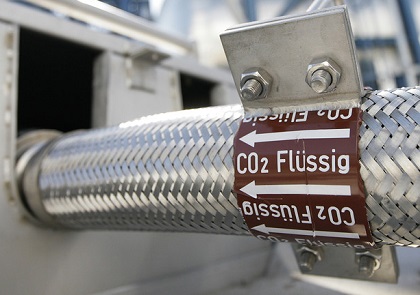
Due to these alarming statistics, investment into carbon capture and storage (CCS) is getting more attention than any point in recent history. Industry experts predict that 90% of the world’s C02 emissions could be captured and stored underground. However, carbon capture has to use energy to capture the Co2, which is problematic in itself.
Brad Page, the CEO of the Global CCS Institute writes:
“The truth is that CCS has much wider applications. It remains the only technology that can deliver deep emissions reductions in hard-to-abate industrial sectors such as steel, fertiliser and cement. Decarbonizing these sectors is not simply about electrifying them with zero-carbon power; most of these processes require either carbon in their chemistry or high heat input, neither of which electricity is able to provide.”
Carbon capture technology can be fitted in industrial plants and power stations to reduce the amount of emissions. Even a historically fossil-fuel driven company such as ExxonMobil, recognizes the importance of doing their part towards change for a sustainable future.
Dr Faith Birol, Executive Director of the International Energy Agency said:
“Without CCS as part of the solution, meeting global climate goals will be practically impossible.”
Further emission reductions
ExxonMobil has been hard at work for the last decade, trying to bring about the future of biofuels. By mass-growing algae’s they hope it will turn into low-emissions biofuels that can reinvent the transportation industry.
On their Twitter page, they highlighted the work they have been doing in the biofuel industry with this timeline:
2009: ExxonMobil joined forces with Synthetic Genomics Inc to create the renewable energy of the future.
2010: Opened a greenhouse at La Jolla, California Campus. Inside that greenhouse Exxonmobil scientists would begin growing algae.
2017: ExxonMobil reports they have made a breakthrough. They say they have discovered a fatter, energy-rich algae strain.
2018: They moved to an outdoor facility at SGI’s California Advanced Algal Facility. This was done to test how large a scale they could grow algae at.
2025: By this year they aim to reach the technical ability to produce 10,000 barrels of algae biofuel per day.
Algae Research Technician at ExxonMobil, Megan Ruhmel explains:
“Algae’s create three things: proteins, sugars and fats. The fuel is actually going to come from the fat part of the algae. Normal algae strains don’t make enough fat for us to get fuel out of. So, we want to make them even fatter than they already are so we can grab the oil from the fat.”
Works Cited
Page, Brad, and Global CCS Institute. “Why Carbon Capture Could Be the Game-Changer the World Needs.” World Economic Forum, www.weforum.org/agenda/2019/03/why-carbon-capture-could-be-the-game-changer-the-world-needs/.
Singapore, ExxonMobil. “We've Had Many Proud Moments on Our Nearly 10-Year Journey to Convert Algae to Low-Emission Biofuel. Here Are a Few of Our Favorites. #UnexpectedEnergy Pic.twitter.com/wPrh0fdiYA.” Twitter, Twitter, 7 Feb. 2019, twitter.com/exxonmobil_sg/status/1093328492857569280.
- Details
- Written by: Quintus Potgieter
The Paris Climate Agreement is ringing alarm bells for engineering industries around the world. The message of the agreement seems clear: transition or die. Extreme weather events, rising sea levels, smog pollution and deforestation issues are no longer something we can undermine.
Australia was one of the participating nations who signed the Paris Climate Agreement in 2015. The Australia Labor Party made a promise to the public that they would cut emissions by 26 percent by the year 2030 if put into power in the next election.

Despite the promise, many are concerned that the party will be all-talk and no action. It seems targeting emissions in all levels of Australian society is a bigger task than the government anticipated as Australia’s emissions have actually been rising.
What is actually being done?
Australia has shown some promise in the photovoltaic sector. There are a significant number of utility solar projects run by both government and business, plus citizens utilize rooftop solar to a noticeable extent.
With so much open space in Australia, many photovoltaic array farms are set up and have been put to work generating electricity. One of those farms being the Bungala Solar Farm. It is currently Australia’s biggest solar farm, currently producing 220 megawatts of electricity.
Another solar farm is also on the way in the Riverina region. The Yarrabee Solar Farm is expected to push out 900megawatts, enough to power one million homes.. It will be located in Yarrabee Park, located in the southwest of New South Wales. The state has been inundated with solar farm projects seeking approval from the government - reportedly 70 projects are waiting to hear if they are eligible to build new solar farms.
Australia’s renewable energy sector is thus more progressive when compared to some other countries, but there is still a long road ahead in the gradual transitioning to cleaner technologies.
More engineering innovation has to happen in almost every industry in Australia in order to make a significant contribution to lessening their carbon footprints. Australia’s emissions from largest to smallest in terms of carbon contribution are as follows:
- Electricity
- Industry
- Transport
- Agriculture
On ABC television network in Australia, the Four Corners investigative journalism program ran a story entitled: Is Australia on track to meet its Paris target?. They pointed out that 19% of Australia’s emissions come from vehicles.
They spoke to The National Roads and Motorists’ Association (NRMA) who said that there should be a ban on new petrol and diesel vehicles as soon as 2025. They also indicated that electric vehicles only accounted for 0.2% of car sales in Australia last year.
They want to see government lead by positive example by using electric vehicles in their own fleets.
What are communities are doing?
Dr Matthew Nott, a local doctor in Tathra, a seaside town in New South Wales, is working to promote renewable energy by highlighting the substantive economic opportunity renewable energy poses. He has founded a community group named Clean Energy for Eternity.
“I hear the excuse all the time that Australia is only worth one percent of the global emissions, so why bother doing anything about climate change? In Tathra, my back of the envelope calculation tells me that we’re worth 0.0005 percent of global emissions. So, we’re a very small part of the problem, but we want to be a big part of the solution.”
The community group got clearance from Tathra to paint a message on one of the local water towers that read: 100% by 2030. The community is trying to be powered by 100% renewable energy in 2030.
The moral of the story seems to be just this: reaching the stringent climate change goals of the Paris Agreement will be an increasingly collaborative effort between government, business and civil bodies.
If all can work together, Australia may just go down in the history books as being a world leader in the renewables sector, and teach the most powerful states a thing or two.
Works Cited
“Is Australia on Track to Meet Its Paris Target? | Four Corners.” YouTube, 1 Apr. 2019, youtu.be/YprAjQr1CuU.
March, Stephanie. “Morrison Says Australia Will Meet Paris Climate Target 'in a Canter', but the Data Says Different.” ABC News, 1 Apr. 2019, www.abc.net.au/news/2019-04-01/is-australia-on-track-to-meet-its-paris-emissions-targets/10920500.
VorrathSophie, Sophie. “NSW Waves through 900MW Solar Farm for Construction in Riverina.” RenewEconomy, 14 Jan. 2019, reneweconomy.com.au/nsw-waves-through-900mw-solar-farm-for-construction-in-riverina-77079/.
- Details
- Written by: Quintus Potgieter
Engineering legacies are all around us. They are constant reminders of the hard work done by engineers who came before us and how, against all odds, they were able to create incredible industries, build amazing marvels, and improve the world that they lived in.
What kind of engineers paved the way for the industries we know and love today? Well as it turns out, they were no different to the engineering students who are endeavoring to change the world we live in today.
Henry Royce never went to university. He was not from a wealthy background, but he had a knack for engineering. He made a career for himself by fitting into technical roles until he eventually founded a company in 1884 known as FH Royce and Company. They would produce dynamos, electric cranes and other small-sized electrical equipment.
Henry Royce was particularly enamored by the sector of mechanical engineering related to motor vehicles. He would be the driving force behind what would one day become one of the world's most renowned automobile engineering companies.

Seeing the world of automobile manufacturing exploding before his eyes, he began work on his own motorcar and called it the Royce. He insisted that every part of the engineering process should never compromise on design or cost - he wanted it to be the best.
So, where exactly does the ‘Rolls’ in Rolls Royce come from?
Charles Rolls was a Cambridge graduate. Being an aristocrat, he loved the finer things in life. His upbringing could not have been more different than that of Royce’s. He too, however, had an affinity for motorcars and was particularly fascinated by the development of aviation.
Charles Rolls met Henry Royce through a mutual friend at the Royal Automobile Club. The friend invited Rolls to see the car Royce had worked on.
He was known to have a preference for four-cylinder cars, whereas Royce's was a two cylinder. But Rolls was sold. From that day onward, Rolls resolved to sell every car Royce engineered. Thus, after a handshake, the Rolls-Royce Company had begun. Royce being the engineer and Rolls as the salesman. A match made in engineering heaven.
In 1904, the first Rolls-Royce 10hp was announced. The Manchester workshops were quickly inundated and could not keep up with demand. They opened more factories in Darby in 1908. The rest is history.
The Rolls-Royce soon became the vehicle manufacturer renowned for the Spirit of Ecstasy mascot fitted to the bonnet and had its rightful place as the most luxurious car in the world.
Alive and kicking
Rolls-Royce is still the brand of choice for the upper class men and women of today. Royce's methodology of never cutting corners and always working with the best materials is currently still in practice.
It is still considered to be the most luxurious vehicle brand in the world. Customers can choose from a range of 44,000 different shades of paint. If customers want a color that isn’t in the 44,000 options, the company will customize the chosen color for the customer.
Rolls-Royce has won the hearts of engineering admirers for their attention to detail. It has made its way into the history book as a British icon. With unparalleled luxury and classic design, everyone knows when they see a Rolls-Royce.

And now, they're leveling up. The company is releasing its first all-terrain SUV called the Rolls-Royce Cullinan. It will bring their kind of luxury into the previously untouched, sturdier class of vehicles.
They're reportedly struggling to keep up with customer demand of the new SUV, with the waiting list currently five months long. According to Car Mag, they have employed 200 employees to meet the demand.
The high demand for Rolls-Royce vehicles speaks to the legacy of Henry Royce and Charles Rolls. It is proof that the hard work and determination that went into the engineering of the many Rolls-Royce vehicles can still be felt 115 years later.
Works Cited
“CULLINAN.” Rolls-Royce Motor Cars Home, www.rolls-roycemotorcars.com/en-GB/cullinan.html.
“Rolls Royce: Dream Machines.” Channel 5, www.channel5.com/episode/episode-1-908/.
- Details
- Written by: Quintus Potgieter
World Water Day (22 March) has come and gone - blink and you would have missed it. However, an organization that didn't miss it was The Institution of Civil Engineers (ICE) in the United Kingdom. They used this day to celebrate the civil engineers making a difference in the world of water infrastructure.
ICE hosted an exhibition with real-life engineers, both active and retired, who dressed up as engineering-inspired superheroes. They hosted two exhibitions named ‘Invisible Superheroes' and ‘Water: From Source to Tap.'
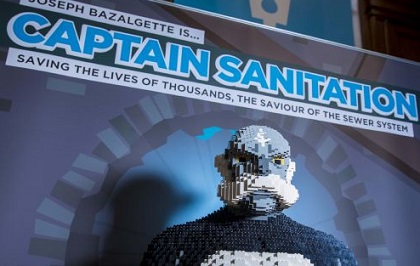
The purpose of the exhibitions was to inform young attendees about career prospects in civil engineering and to speak about the importance of clean water in our future. The ‘superheroes' were there to also inform about threats to the water infrastructure in the UK; mainly, ‘fatbergs and flooding.'
Fatbergs are masses of solid waste that get lodged in sewerage systems. These piles of waste mainly consist of congealed fat which has been poured down household drains and personal hygiene products that have been flushed down household toilets. London's Victorian-era sewer system sees these fatbergs all too often, and civil engineers are who have to deal with them.
After clearing the fatbergs from the sewer system, they are handed over to others in the engineering industry that turn the discarded waste into biofuel. The process is shown in this video:
A company known as Thames Water spends around one million pounds per month clearing fatbergs and blockages from sewer systems in London. Their total of fatbergs cleared nears around 55,000 per year.
Martyn Harvie, a principal engineer appearing at ICE's exhibition as superhero Drainage Dyno told WWT Online said:
“People are prone to ‘flush and forget,' not thinking about the environmental consequences. But responsible water management is vital for a sustainable future. By revealing the secrets beneath the sewers, ICE hopes to warn people ‘Don't Feed the Fatberg’ and raise awareness of all the behind-the-scenes work that civil engineers do to manage our precious water resources.”
Works Cited
“HOW MUCH DO 'FATBERGS' COST THE PUBLIC?” Daily Mail Online, Associated Newspapers, 2 Aug. 2018, www.dailymail.co.uk/sciencetech/fb-6019745/HOW-FATBERGS-COST-PUBLIC.html.
"ICE Launches Exhibition Showing Water's 'Superheroes.'" WWT, wwtonline.co.uk/news/ice-launches-exhibition-showing-waters-superheroes.
- Details
- Written by: Quintus Potgieter
A priority of all engineering companies is the implementation of workplace safety and with the development of new safety technologies, industrial environments are closing than ever to achieving accident-free workplaces.
British-Dutch oil and gas company Shell has pledged for the last five years to continually ensure impeccable safety across every level of their company.
It all started with their Goal Zero ambition to achieve no harm and no leaks across all of their oil-related operations and then spread out to their other enterprises. The goal is outlined on their website and says:
“To achieve Goal Zero, we focus on the three areas of safety hazards which have the highest risks for our type of activities: personal, process, and transport safety. We set consistent, high safety standards across Shell and we expect all of our employees and contractors to meet them..."
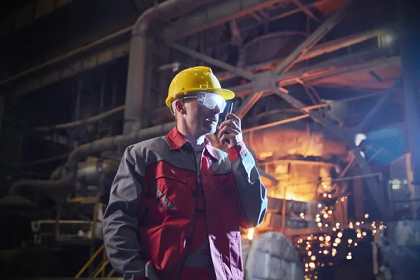
Safety in the Engineering industry is a leading example of teamwork with many companies working together to collaborate on safety standards.
Shell currently shares their safety standards with other trade associations and professional bodies in the sector including The International Association of Oil and Gas Producers and The American Petroleum Institute.
“A strong safety culture is complemented by a competent workforce. We ensure that people responsible for tasks with a significant safety hazard have the necessary training and skills. Our safety experts work in networks to share and implement best practices around the world.”
Safety is something that can always be built upon; companies can help improve their safety by studying part time courses such as the Professional Certificate of Competency in Hazardous Areas that is offered at the Engineering Institute of Technology. These courses are specifically tailored to those working in hazardous engineering environments.
Inquire about which courses have safety modules mixed in by visiting the Engineering Institute of Technology’s website.
IIoT = safety for workers
Industrial environments are usually cardio-vascular intensive environments and made more dangerous with the use of heavy machinery.
To prevent the probability of future workplace accidents, the Industrial Internet of Things is augmenting safety measures in the industrial workplace.
The development of machine learning, artificial intelligence (AI) and physical hardware - like wearables - is helping workers stay safe, and helping companies have more oversight over their workers and machinery than ever before.
Now, IIoT-connected devices are generating safety data, and can even be used in emergency situations. A company that is developing solutions for workplaces with all of this in mind is IBM, who has begun to utilize their AI invention Watson for the purposes of workplace safety in industrial organizations.
Engineering.com spoke to Ishan Sehgal, who is a director for Watson IoT Industry Solutions.
“Worker safety solutions are one of our portfolio products that we have based on Watson IoT platform. The bottom layer is the IoT platform that provides the data connection, data collection, data curation at a device or device data level. Upstream from that is our industry solution, whether it’s around predictive maintenance, which is involved a lot around assets analytics; whether it’s around manufacturing processes, which includes solutions like predictive quality insights (PQI) that looks at industrial processes and analytics around the process or worker insights -- collecting data from and around the worker based on wearables or beacons or other devices in a production environment.”
Works Cited
Maw, Isaac. “Using IIoT-Connected Devices for Worker Health & Safety.” Engineering.com, www.engineering.com/AdvancedManufacturing/ArticleID/18873/Using-IIoT-Connected-Devices-for-Worker-Health-Safety.aspx.
“Our Approach.” Shell Global, www.shell.com/sustainability/safety/our-approach.html.
- Details
- Written by: Quintus Potgieter
India’s government is under scrutiny after a bridge collapse in Mumbai left at least six people dead and 36 people injured.
This is the third foot-overbridge tragedy India has seen in just two years, placing a harsh spotlight on the shortcomings of India’s infrastructure sector who struggle to stay up to date with modern practices and maintenance requirements.
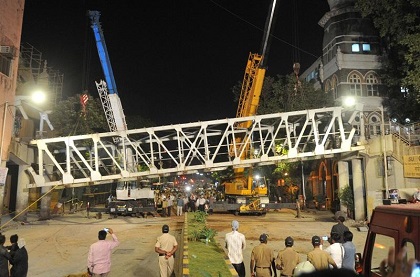
Shirish B Patel, an urban planner and civil engineer, says that what’s happening in the case of the various bridge collapses is a result of hastily appointed designers and engineers who are not necessarily the most skilled but the cheapest to hire.
“Over time the quality of design is sure to degrade, as designers pursue lowering costs and cutting corners rather than enhancing their skills. Salaries are cut, fewer of the brighter students enter the profession, and the downward spiraling cycle continues.”
Just four days after the collapse, Neeraj Kumar Desai of Prof D.D.Desai’s Associated Engineering Consultants and Analysts was arrested for what the Indian Express news service called ‘submitting faulty audit reports to the civic body.'
Mr. Desai apparently neglected to tell official bodies that the bridge was in trouble of collapsing. Re-audits have now been issued for all the bridges in the city.
The issue of aging infrastructure is nothing new and something all countries in the world have to deal with. A recent report by the U.S. Department of Transportation has revealed that more than 54,000 American bridges are structurally deficient.
And as our global populations grow and increasingly migrate closer to inner cities, the infrastructure sector has no room for error.
Luckily, the civil engineering industry is seeing a range of new technologies and methodologies introduced into the sector, which promise to make processes more efficient and make structures more stable.
Works Cited
Marpakwar, Chaitanya. “MNS Not to Contest Lok Sabha Elections.” Mumbai Mirror, Mumbai Mirror, 18 Mar. 2019, mumbaimirror.indiatimes.com/mumbai/other/mns-not-to-contest-lok-sabha-elections/articleshow/68456530.cms.
Rajput, Sagar. “CST Foot Overbridge Collapse: Director of Firm That Audited Bridge Arrested.” The Indian Express, 19 Mar. 2019, indianexpress.com/article/cities/mumbai/mumbai-bridge-collapse-auditor-arrested-after-preliminary-inquiry-report-reveals-negligence-5632727/.
- Details
- Written by: Quintus Potgieter
At the Mobile World Congress 2019, Microsoft came out swinging. They announced the second iteration of their mixed-reality headset, the Microsoft HoloLens. It is aptly named the HoloLens 2.
The new headset will cost US $3,500 but will only be available to companies - and not consumers - for now. The HoloLens is a head-mounted (wearable) technology that integrates 3D virtual elements within the field of view of the wearer.
The HoloLens only weighs 1.25lbs (0.57kg) and fits comfortably on the head. On the back of the wearer's head lies the battery and processor. On the front, a flip-up visor fitted with very sophisticated technology that has been tweaked to give the wearer a wider field of view than its predecessor.

The new display technology in the current HoloLens employes is a novelty designed by Microsoft. Each eye sees a resolution of 2K. The new Lens uses lasers which projects the images onto mirrors that are spinning at 54,000 revolutions per second. The mirrors reflect the images being projected onto a slate of glass placed in front of the eyes of the wearer.
General Manager of Optics Engineering at Microsoft, Zulfi Alam, said: “There’s no competition for the next two or three years that can come close this level of fidelity.”
Equipped for the industrial and education future
Microsoft says for now they are aiming to test the technology with workers in ‘auto shops' and on ‘factory floors' and ‘operating rooms.' Microsoft has partnered up with a company named PTC. The company is at the forefront of digital transformation solutions through its utilization of the Industrial Internet of Things.
The HoloLens can simulate in real time engineering processes that might have taken many weeks and many prototypes later. The HoloLens allows engineers to see 3D CAD software feedback in real time, simulating an engineering process or product without actually having to produce it physically.
On factory floors, preventing downtime is imperative. PTC says that innovative technologies like the Internet of Things and mixed reality (MR) can help manufacturers ‘monitor and service their smart, connected products.’ On their website, they write:
“Industrial IoT data enables manufacturers to monitor the condition of their smart, connected products so they can accurately predict optimal maintenance and service times that will have the least impact on operations.”
On the front of the HoloLens, a spatial mapping sensor scans the room the wearer is in so that it can accurately and proportionately project the 3D objects in augmented reality. This makes it especially useful for engineers who want to see where large machinery will go on a manufacturing floor.
The act of simulating engineering processes and products in mixed reality is particularly noteworthy for its positive spin-offs for engineering education and training in the future. Students and in-training engineers in engineering industries can see learn through the technology to perform practical tasks in real-world scenarios.
Works Cited
Bohn, Dieter. “Microsoft's HoloLens 2: a $3,500 Mixed Reality Headset for the Factory, Not the Living Room.” The Verge, The Verge, 24 Feb. 2019, www.theverge.com/2019/2/24/18235460/microsoft-hololens-2-price-specs-mixed-reality-ar-vr-business-work-features-mwc-2019.
Kaminsky, Greg. “Enhancing the Customer Experience with IoT-Driven Mixed Reality.” PTC, PTC, www.ptc.com/en/thingworx-blog/iot-driven-mixed-reality.
- Details
- Written by: Quintus Potgieter
It seems engineering terms are becoming buzzwords within the industry.
For example, words like The Fourth Industrial Revolution, the Internet of Things, Artificial Intelligence, the Blockchain — and more — are all misused in quickly rattled off articles and political speeches.
In fact, it seems that the people peddling these terms are not actually aware of their meaning. It is easy to refer to the Fourth Industrial Revolution without giving credence to the technologies that are bringing the revolution about.

The risk is that engineers entering the industry might be unsure of which type of engineering to pursue when buzzwords are being thrown from all angles. When it comes to terms like the Internet of Things and Artificial Intelligence...it’s a delicate balance.
IoT vs. AI: Which way forward?
The Internet of Things refers to connecting machines together and harvesting the data that they generate, whereas Artificial Intelligence is about engineering an intelligence comparable to human intelligence.
The overarching difference is who interprets and essentially makes sense of the data. Thus, AI can be plugged in at the technological level that can make sense of the data generated by Internet of Things technologies. As a result, in some instances, some systems can be interconnected in an Internet of Things network and have an artificially intelligent software making sense of the data it is receiving.
However, a new report by EE Times has taken a look at the revenue expectations for the Worldwide Deep Learning Chipset industry. The report seems to indicate that ‘five-sixths of the growth in semiconductors' will be in AI technologies alone by the year 2025.
The Internet of Things, merely a technological shift where an interconnected network of things (or computers) talk to each other, may be on the back foot of the semiconductor industry because AI setups are usurping that sector.
Analyzing data with deep-learning algorithms seems more of a technical task than connecting things together and needs other AI technology altogether. CPUs, GPUs, and the like are unable to process the data networks generate as effectively as algorithms can, and so those technologies fitted with the correct semiconductors have reached the market and are ready to do the job.
So what kind of semiconductors can prospective engineers expect to see in the industry? Application-specific integrated circuits, application-specific standard products, systems on a chip, and accelerators for artificial intelligence. Each chip being algorithm specific in its own right.
Those algorithm-specific and application-specific semiconductors are tailor-made for, for example, autonomous vehicles, Wall Street, farming technology, weather forecasting, etcetera.
The Engineering Institute of Technology is delivering a Professional Certificate of Competency in Machine Learning and Artificial Intelligence. The course will begin on 13 May 2019. The course is presented by industry lecturers with more than 15 years of experience in the development and management of artificial intelligence. The course teaches students incredible problem-solving skills in the machine learning world and trains them in building algorithms to automate processes regardless of the industry.
Enquire about the course today and start clearing up the basics, and start your journey on focusing what the engineering industries that exist require right now.
Works Cited
Shuler, Kurt. “IoT Was Interesting, But Follow the Money to AI Chips.” EETimes, EE Times, 20 Feb. 2019, www.eetimes.com/author.asp?section_id=36&doc_id=1334342.
Sync, CRM. “The Future of IOT Is AI.” TechUK - Representing the Tech Industry in the UK, TechUK, www.techuk.org/insights/opinions/item/13827-the-future-of-iot-is-ai.
- Details
- Written by: Quintus Potgieter
A decade of corruption, mismanagement, sabotage, poor power station designs, and a recent natural disaster has led to the implementation of more rolling blackouts in South Africa's energy sector.
At the end of 2018, Eskom admitted that they were unsure when the next break in transmission was going to be. Initially, they wanted to ensure that South Africans would not be in the dark during their Christmases.
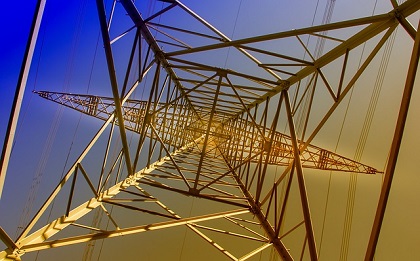
During that time, an intensive investigation into the problems Eskom was experiencing was launched. They were looking for good, honest people with the right technical skills. They did not want Stage 2 load-shedding. However, three months later, the country would see an unprecedented Stage 4 load-shedding. For each customer, for an entire week, their electricity would be cut off twelve times, for two-and-a-half hours each time.
Eskom has 47,000 MW of installed capacity that is serving all South Africans. The current demand of South Africans at a theoretical peak during the summertime is 29,000MW. The demand Eskom is able to reach (with all of their problems considered) is about 26,000MW.
Eskom indicated that a contributing factor to their woes was the age of their plants was a massive problem, too. Monetary investment into the maintenance of the plants in the last few years, but they allege that the repairs were not done adequately.
Eskom is hoping to find the relevant skilled individuals who can quickly meet the requirements of the state-owned enterprise. They need the right people to take a look at their problems and suggest implementable solutions.
So, how can freshly qualified engineers or even students help solve the problem?
Managers, students, professionals
It is imperative that all professionals and future professionals in the electrical engineering industry in South Africa keep upskilling within the industry. They never know when a state-owned electricity utility could be knocking on their door and asking them to save the day.
Public Enterprises Minister Pravin Gordhan at a press conference on the 6th of December 2018 said:
“We are going to find independent experts, a few of them, so that they could take an arm lengths view of these plans and the nature of the problems, and the nature of the solutions we have prescribed.”
Gordhan said in December that Eskom was in crisis mode. He said they would look within the company to find capable individuals to become power station managers to ensure power stations ran at an optimal level with zero incompetence.
After looking inward, they began looking outward as well. At the beginning of 2019, Eskom began asking top engineers from Italian energy company Enel to assist with Eskom's maintenance issues.
Chairperson on the board of Eskom, Jabu Mabuza said:
“This cannot be solved by Eskom alone. These are problems that we have all caused as South Africans. Either through our people, or through our government, but these are problems that we have caused. So, there is a role that we all have to play - shareholders, providers of capital, staff, customers - this is a choice of pain we need to take going forward, to try and put us back into a sustainable way.”
The company has approached the Auditor-General and the National Treasury to secure a special procurement dispensation to pay professionals for their assistance with their services and expertise. They are hoping that these companies and the ultimately skilled individuals might help keep the lights on.
Gordhan also mentioned to media recently that they were head-hunting at universities for students who could take a look at the power stations and provide feedback and suggestions for how Eskom might better run them.
What is also clear is that the stage is set for more Independent Power Producers to flood into the energy industry in South Africa. There is also a US $310 million government fund ready to invest into small scale embedded generation (SSEG) projects which will also create new jobs for highly technically qualified engineering professionals and workers, but the fund has been held back because of regulatory constraints.
There are also regulations preventing individual municipalities in the country from generating their own electricity. The state-owned utility has taken that entire job on its own shoulders. Opening up the regulations allows for municipalities to hire professionals to build a brand new, unique grid and would lead to far more citizens getting access to electricity - perhaps some for the first time.
The result could see engineering professionals getting jobs in general and renewable energy projects the country desperately needs to keep the lights on and to circumnavigate load shedding on already aged infrastructure. It could take many homes, businesses, warehouses, factories, mines, and farms off of the national grid and reallocate the electricity for areas that are in desperate need of it.
As a result, South Africa’s electricity problems also present the country with opportunities. As the country draws closer to their next election, electricity (and the lack of it) will be something the voters might have at the back of their minds as they cast their vote.
Works Cited
6 Quick Fixes That Can Save South Africa from More Load Shedding, www.businessinsider.co.za/6-quick-fixes-that-can-save-south-africa-from-more-load-shedding-2019-3.
“Eskom, Gordhan Briefing on Operation Issues.” YouTube, 6 Dec. 2018, youtu.be/3KXg_o5Zth0.
- Details
- Written by: Quintus Potgieter
Remote invigilation - otherwise known as online proctoring - might just be the critical factor when measuring the success of online higher education. Online education without digital supervision would naturally be a sticking point for education accreditation boards across the globe. It is not surprising, therefore, that online proctoring solutions are growing.
The Engineering Institute of Technology (EIT) have been hard at work developing the IRIS Invigilation (IRIS). It is a cloud-based platform which utilizes machine learning to monitor students during online examination and tests.

This software program helps provide educators assurance of assessment integrity during online and remote assessment. IRIS records audio, video, and computer screen activity for the duration of a test/exam. It analyses this information using machine learning and automatically flags potential academic dishonesty displaying the data in an easy to use reporting dashboard.
Screenshots are taken at intervals and sent to the invigilating program, this is to double-check what students are seeing on their screens. If anything other than what should be there is detected, the program flags this as suspicious.
IRIS is cloud-based – this means that no heavy software is required on a student’s device; in fact it is so lightweight it can run on a web browser. Furthermore, because the machine learning is largely responsible for identifying potential cheaters, the requirement for staff involvement drops off significantly.
A big benefit to the system is the learning analytics that provide incredibly detailed insight into educational trends and patterns based on real student data. Curtin University told IT News that they hope to see the invention make its way to the ‘rest of Australia's 700 Vocational Education and Training providers’.
A new chapter in online education
Perfecting online proctoring is of utmost importance considering the global online education market is projected to reach a total market size of US$286.62 billion by 2023, as reported by Research and Markets. This means more and more students are opting for online study - but invigilating those students remotely, during examinations, is a tall order. An excerpt of the report reads:
“Platforms that facilitate learning through gaming are gaining popularity, improvements in IT security and implementation of cloud based solutions has increased the adoption rate of online education system as now, people can enjoy a smooth learning experience on safe online platforms. Advancements in the field of artificial intelligence are expected to further boost the growth rate of the online education market.”
Although critical in the virtual classroom, online invigilation is likely to become a useful tool in the physical classroom too – as part of an on-campus, hybrid learning invigilation system. The problems with on-campus invigilation are prompting the change; these include the need for a battalion of human invigilators and the greater margin for error (whereas an automated system can monitor students individually).
In South Africa for instance, even at the Further Education and Training phase (Grades 10 to 12), the Independent Examination Board has instructed schools to install invigilation cameras in any venue where examinations take place.
It is clear that invigilation technologies are becoming more vital to education institutions around the world, but especially to legitimize online education once and for all.
Works Cited
Johnston, Matt. “Benchmark Awards 2019 Finalists: Curtin Uni Remote Exam Invigilation.” ITnews, 4 Feb. 2019, www.itnews.com.au/news/benchmark-awards-2019-finalists-curtin-uni-remote-exam-invigilation-518736.
ltd, Research and Markets. “Global Online Education Market - Forecasts from 2018 to 2023.” Research and Markets - Market Research Reports - Welcome, www.researchandmarkets.com/research/nzxrnp/global_online?w=4.
- Details
- Written by: Quintus Potgieter
Twenty-five percent of engineering graduates are jobless in India, according to a study published by the All India Professionals Congress. Whereas a study published 1,618 miles away, in the United Arab Emirates, indicates that there are not enough graduates to go around. This is in a region where engineers are highly sought after.
The study in the UAE was named ‘Majors in Demand’ and was conducted by the Ministry of Education. The study took a look at over 13,000 graduates from government and higher education institutions who graduated in 2017.
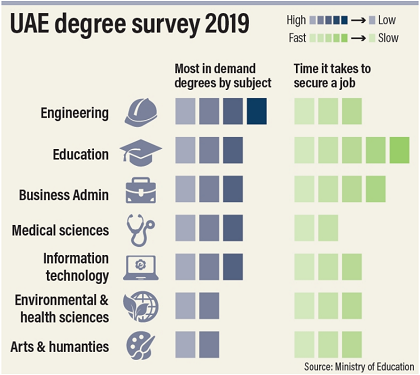
They found that civil engineers were most in demand, but believe that their findings would be a useful guide to undergraduates generally.
The Minister of State for Higher Education and Advanced Skills in the UAE told state media:
“This study is an ideal forecasting tool for students”
The study in India paints a grimmer picture than that painted by the UAE. The country seems to have a glut of engineering graduates with not enough jobs available for them.
The report out of India comes from the All India Professionals Congress. They canvassed 2,600 engineering graduates, finding that 25 percent of the graduates were unable to find employment.
All India Professionals Congress secretary Sudheer M told media:
“It is the need of the hour that we consider education a serious factor in the country’s progress. This prompted me to conduct a study of engineering education to start with.”
The Times of India goes on to report on which graduates are having more luck: mechanical engineers are most likely to be employed, but that civil engineering graduates are also being hired.
Of the students canvassed, however, 80 percent indicated that they felt a lack of connection to the engineering industries in the country.
This connection to industry is something the Engineering Institute of Technology (EIT) feels is critical to a graduate’s success. And to this end the college works hard to contextualize all theory, add real practice into the engineering bachelor and master degrees and expose students to the relevant industries during their studies.
EIT also ensures that their industry-driven content is presented by experienced engineers from around the world. The online students interact with these experts in real time and the students on campus in Australia receive a combination of face-to-face teaching and globally-based lecturers streaming into their classrooms. EIT believes that graduates who are immersed in real engineering, throughout their studies, are more likely to find the jobs they dream of.
Works Cited
NewIndianXpress. “25 Per Cent Engineering Graduates Are Jobless, Says Study.” The New Indian Express, The New Indian Express, www.newindianexpress.com/states/kerala/2019/feb/03/25-per-cent-engineering-graduates-are-jobless-says-study-1933544.html.
Nowais, Shireena Al. “Engineering Graduates Most in Demand in UAE.” The National, The National, 9 Jan. 2019, www.thenational.ae/uae/education/engineering-graduates-most-in-demand-in-uae-1.811254.
TOI-Online. “Which Branches of Engineering Has the Highest Demand? - Times of India.” The Times of India, Business, 16 Jan. 2019, timesofindia.indiatimes.com/home/education/news/which-branches-of-engineering-has-the-highest-demand-bu/articleshow/67555535.cms.
- Details
- Written by: Quintus Potgieter
Conflict and war are commonplace around the world and civilians are inevitably trapped in the midst of them. It is gratifying to report that engineering skill, in conjunction with technology, are working to alleviate some of the fall-out for the people caught up in these situations.
This doughty combination of technology and skill is making relief efforts more manageable: getting food, water, and medicine to those regions effected by war. It is also proving remarkably effective in remote areas.
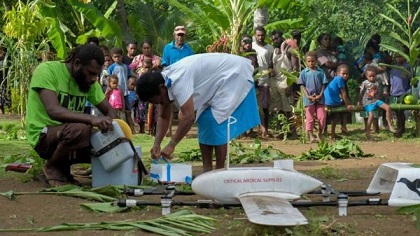
Australian company, Swoop Aero, is using drones specifically built for the betterment of healthcare. The company has been founded for the purpose of ‘redefining healthcare with airborne mobility’.
The company operates an on demand, high speed, autonomous airborne logistics network. And they have proven their usefulness on the Pacific island of Erromango, in Vanuatu.
ABC News was with the Australian company while they delivered vaccines to the island; an island notorious for low vaccination rates for children.
Separately the people of Erromango have been suffering with hepatitis and tuberculosis; vaccines for these maladies have also been successfully deployed by Swoop Aero.
UNICEF comments that Vanuatu’s ‘extreme remoteness’ makes delivery of vaccines, via traditional methods, very difficult. The nation is in fact an archipelago - made up of roughly 80 islands that stretch over 1,300 kilometers.
The United Nations International Children’s Emergency Fund (UNICEF) chartered the drone flights from Swoop Aero which are perfectly engineered for autonomous vaccine delivery.
On the company’s website Swoop Aero asserts that the drones can navigate the most hard-to-reach areas of the world. They write:
“Inhospitable terrain, unpredictable waterways, mountain ranges, poor infrastructure, traffic congestion, and long distances limit the capabilities of ground transport.”
The drones can travel at 100 kilometers per hour and are powered by batteries.
Unexpected variables
Nurses sometimes hike to reach the villages with the medicines they think the children and adults require. The villagers, however, often move from place to place, making it difficult to estimate the needs of each community. The drones proffer a solution because of their ease of mobility; they are more ably meeting the demands of the villages.
The price of drones has dropped considerably too, despite improvements to the technologies powering them. This drop in cost is making their use more viable in rural and remote villages.
Eric Peck, co-founder of Swoop Aero, told ABC News:
“It’s something that has been around for quite a while now, but we’re at this inflection point where for the first time we are seeing the cost of technology get down to a point where it’s economically efficient to use it.”
The Australian company is officially trialing the drones in Vanuatu and will measure the success of the project on completion. The system appears to be working with the backing of the Vanuatu government, UNICEF and the Australian government.
This is another example of how engineering can shape the world’s landscape for the betterment of humankind.
Works Cited
Dziedzic, Stephen. “A Two-Day Walk for Vaccines Is Now Just 20 Minutes Away with Drone Delivery in Remote Vanuatu.” ABC News, Australian Broadcasting Corporation, 18 Jan. 2019, www.abc.net.au/news/2019-01-19/using-drones-to-deliver-crucial-vaccines-to-remote-vanuatu/10728350.
Peck, Eric. “Vanuatu Uses Drones to Deliver Vaccines to Remote Island: BBC.com.” Swoop Aero, swoop.aero/swoop.aero/vanuatu-uses-drones-to-deliver-vaccines-to-remote-island-bbc-com/.
- Details
- Written by: Quintus Potgieter
South Africa is a country with 27% of its population without work. Spirits have not been high for at least a decade; a struggling economy has been limping around entrenched and widespread governmental corruption. Thanks to a recent discovery, however, followed by an announcement by integrated oil and gas company Total, the country has perked up a little. Total said in a statement:
“We have made a significant gas condensate discovery on the Brulpadda prospects in the Outeniqua Basin, 175 kilometers off the southern coast of South Africa.”
The CEO of Total, Patrick Pouyanne, told journalists that there “could be around one billion barrels of global resources, gas and condensate light oil”. The site, in deep waters 175km off of the country’s southern coast, is in the proximity of a town named Mossel Bay.

Kevin McLachlan, senior vice-president of exploration at Total told the Financial Times:
“With this discovery, Total has opened a new world-class gas and oil play and is well positioned to test several follow-on prospects on the same block.”
South Africa benefits greatly as well. The country has been relying on oil imports for its national needs - now it is right on the doorstep. Experts say the find could lead to a growth of South Africa’s economy to the tune of more than USD $73 billion - or R1 trillion.
With a rig to be set up just off the coastline the South African Oil and Gas Alliance will be focusing on how to develop the skills of workers and ensuring engineering professionals are prepared for the forthcoming projects.
The announcement of the discovery came just at the right time for President Cyril Ramaphosa’s State of the Nation Address. Ramaphosa hoped the speech would encourage investor confidence in the country. In the speech about Total’s discovery, he said:
“Last night I received a call from Minister Gwede Mantashe {Mineral Resources Minister}. He told me that the oil giant Total would be making a big announcement today about a new ‘world-class’ oil and gas discovery off the coast of South Africa. We are extremely encouraged by the report….. which some have described as a catalytic find. This could well be a game-changer for our country and will have significant consequences for our country’s energy security and the development of this industry. We congratulate Total and its various partners and wish them well in all their endeavours. Government will continue to develop legislation for the sector so that it is properly regulated for the interests of all concerned.”
Eye Witness News reported that PetroSA is also very happy with the announcement. Their gas-to-liquid plant is allegedly running lower than 50% of its design capacity. This is heartening for the labor market too with the likely growth in jobs, from rig to refinery.
The next step for Total is utilizing 3D seismic data measuring equipment, after which drilling can begin. The drilling alone will reportedly be the largest scale hydrocarbon exploration project in the world.
Works Cited
Keohane, David. “Total Strikes South African Oil and Gas Find.” Financial Times, Financial Times, 7 Feb. 2019, www.ft.com/content/07b7798c-2abc-11e9-a5ab-ff8ef2b976c7.
Lauren Isaacs. “SA Offshore Gas Find Could Yield 1 Billion Barrels, Says Total.” Eyewitness News, 7 Feb. 2019, ewn.co.za/2019/02/07/sa-offshore-gas-find-could-yield-1-billion-barrels-says-total.
- Details
- Written by: Quintus Potgieter
It is never pleasant to focus on engineering industry shortcomings. However, when new aircraft fall out of the sky, with multiple fatalities the result, the ugly business of discovering the faults commences.
On Sunday, 10 March 2019, a Boeing 737 MAX 8 (flight ET302) belonging to Ethiopian Airlines crashed just six minutes after takeoff from Addis Ababa. It went down on its way to Nairobi, Kenya, crashing into a town known as Bishoftu. Of the 157 people onboard, there were no survivors.
This crash was eerily similar to the Indonesian Lion Air Flight 610 which went down over the Java Sea in October 2018. It was the fact that they were both Boeing 737 MAX models which resulted in the inevitable comparisons. Both aircraft were iterations of a new series touted as ‘technologically advanced’ and more efficient than planes that had come before.
Worryingly, in both crashes the aircraft were only months old – essentially brand new. The US Federal Aviation Administration (FAA) reports that th
“The unmatched reliability of the MAX means more 737 flights depart on time with fewer delays. And technological advanced plus powerful LEAP-1B engines are helping to redefine the future of efficient and environmentally friendly air travel.”
Upon hearing the news of the Ethiopian Airlines crash, Chinese, Singaporean, Indonesian, Australian, Mexican and Argentinian airlines temporarily grounded their 737 MAX planes almost immediately – a ban which has now become a global one. Consultations with Boeing’s engineers and technical experts has begun, as has an investigation into what caused the Ethiopian plane to crash.
The United Kingdom took a hardline stance on the 12th of March 2019, the Civil Aviation Authority confirmed that they would ban all 737 MAX aircraft and would not allow any to enter UK airspace.
The regulator said in a statement:
“We have, as a precautionary measure, issued instructions to stop any commercial passenger flights from any operator arriving, departing or overflying UK airspace.”
This caused chaos for passengers - with some flights being diverted or turned back midair!
American President Donald Trump also weighed in on the conversation about modern day aircraft. Two days after the Ethiopian Airlines crash he tweeted:
“Airplanes are becoming far too complex to fly. Pilots are no longer needed, but rather computer scientists from MIT. I see it all the time in many products. Always seeking to go one unnecessary step further, when often old and simpler is far better. Split second decisions are needed, and the complexity creates danger. All of this for great cost yet very little gain. I don’t know about you, but I don’t want Albert Einstein to be my pilot. I want great flying professionals that are allowed to easily and quickly take control of a plane!”
Over complicating the aircraft?
Experts are treating both the Lion Air and Ethiopian Airlines crashes as suspicious. The Indonesian flight going down 13 minutes after take-off and the Ethiopian one going down after just 6 minutes is alarming aviation analysts.
Boeing has announced that it will release software updates for the 737 Max jets by April. The work on the software tweaks started after the Lion Air disaster. This began after it was reported that the pilots in the Lion Air disaster had trouble with a new feature added to the Maneuvering Characteristics Augmentation System (MCAS). It is alleged that the pilots may have not had any control over the plane after the MCAS software kicked in.
The MCAS was implemented when they noted that the new engines Boeing had fitted to their 737 tended to push the aircrafts’ noses upwards. The MCAS sensors were designed to respond to the aircrafts’ upward nose tilt and trigger the software to push the plane into a semi-nosedive to prevent a stall. It is alleged that the software reacted when the planes were still climbing and pushed the two planes into nosedives which the pilots could not correct.
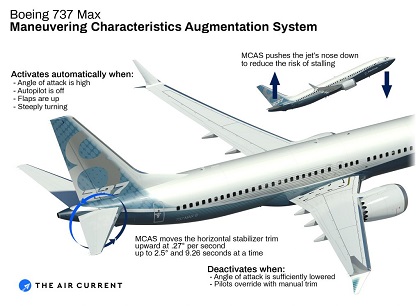
Boeing later said that the pilots in the Lion Air disaster should have taken the necessary steps to disable the software.
Boeing, after the Ethiopian Airlines crash, has had to defend their software, indicating that pilots do have the ability to override the software.
“It was put through flight testing as part of the certification process prior to the airplane entering service. MCAS does not control the airplane in normal flight; it improves the behavior of the airplane in a non-normal part of the operating envelope.”
Works Cited
Bazley, Tarek. “Control System under Scrutiny after Ethiopian Airlines Crash.” News | Al Jazeera, Al Jazeera, 11 Mar. 2019, www.aljazeera.com/news/2019/03/control-system-scrutiny-ethiopian-airlines-crash-190311094532350.html.
“Boeing.” Boeing: Philip M. Condit, 109380-Leslie Nichols, www.boeing.com/commercial/737max/.
Ostrower, Jon. “What Is the Boeing 737 Max Maneuvering Characteristics Augmentation System?” The Air Current, 23 Nov. 2018, theaircurrent.com/aviation-safety/what-is-the-boeing-737-max-maneuvering-characteristics-augmentation-system-mcas-jt610/.
- Details
- Written by: Quintus Potgieter
Planet Labs has launched 146 satellites into space — officially it's the largest fleet of satellites in human history. The company began engineering the satellites with the intention of making each one roughly the size of a loaf of bread. They each weigh 12 pounds (5 kg).
The satellites are engineered by former NASA employees. Unlike when they were working for NASA, the turnaround time for the creation of these satellites is much shorter. They are as easy to design and build as a smartphone is.
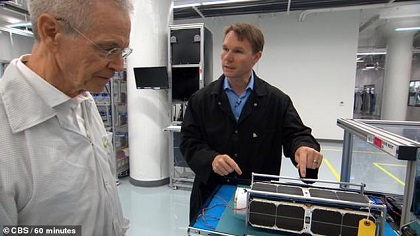
The satellites orbit the globe every 90 minutes taking photographs of the earth below. Co-founder of Planet Labs Dr. Will Marshall spoke to the news program, Sixty Minutes, about what can be seen on the images these satellites take of the earth. He said:
“We see rivers move, we see trees go down, we see vehicles move, we see road surfaces change and it gives you a perspective of the planet as a dynamic and evolving things that we need to take care of.”
They call the satellites doves and release them in flocks. 28 small satellites have recently been launched by astronauts aboard the International Space Station. The flocks spend their time snapping away, generating many images of the ever-changing earth, providing insights for those viewing them. The satellites generate 1.2 million photographs every 24 hours.
Planet Labs now allows companies, academics, farmers, and governments to access their data sets and images for research and — in the government's case — spying on other nations. They currently have 200 customers that utilize their images of the globe.
Planet Labs is now giving the U.S. government a much clearer picture of parts of the earth that they have never been able to investigate before.
Historically, dozens of engineers would have to be working on one satellite, but the company has revolutionized the industry. Making the satellites and more manageable has led to one engineer working on a dozen satellites. They have turned the tables on the satellite industry. The company has engineered around 300 satellites over the years, refining and learning from the process as they go along.
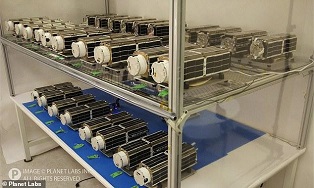
And sometimes, those lessons have been hard ones. On one of their launches, 26 satellites were destroyed in a launch accident when one of their rockets sending satellites up to the space station fell to the ground and exploded. The engineers immediately snapped back into action and quickly began work on meeting the demand for those lost satellites.
The founders of Planet have seen technology develop in record time. In their careers at NASA, it would take 5 to 10 years to get a satellite to space - now, it takes only a couple of weeks.
Works Cited
“Private Company Launches ‘Largest Fleet of Satellites in Human History’ to Photograph Earth.” CBS News, CBS Interactive, www.cbsnews.com/news/private-company-launches-largest-fleet-of-satellites-in-human-history-to-photograph-earth-60-minutes/.
- Details
- Written by: Quintus Potgieter
Toshiba Corp and General Electric have unveiled the robot that will again try to achieve what no robot has been able to accomplish before it; locating and removing the spent, melted nuclear fuel of the Fukushima Daiichi nuclear reactor number three.
The cleanup and decommissioning of the three nuclear reactors that fell victim to meltdowns after a powerful earthquake and subsequent tsunami in 2011 is ongoing. The cleanup will cost the equivalent of USD$190 billion.
The path to decommissioning began with locating the spent, melted nuclear fuel inside the reactors. No human can withstand the radiation levels present in the reactors. Consequently, radiation-resistant robots have been sent down to attempt to locate the fuel. But, all the robots that were entrusted to finish the job have all stopped short due to the large radioactivity present in the reactors.
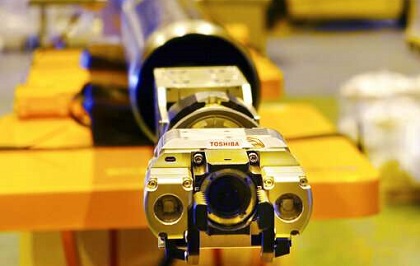
However, a probe with a camera attached to it successfully managed to get images of the melted fuel in Unit 2’s reactor last year. The other two reactors’ melted fuel is still unseen, but engineers are confident they have detected it and can find it easily.
Back in 2017, the cleanup crew sent a Toshiba robot named the Scorpion Robot down to the No. 2 Reactor. The radioactivity caused the robot to stop midway and disabled one of the wheels. There is still no indication of where the spent fuel exactly is.
Engineers have tried four-legged robots, stair-climbing robots, robots with wheels, robots that could swim through water, and more. They all seemed to be unable to complete the mission.
In with the new
The new robot by Toshiba Energy Systems & Solutions Corp and GE is a device engineered to traverse into the hard to reach places in the nuclear reactors. The robot will go down an 11-meter long pipe and will be in reach of the melted nuclear fuel in Unit 2.
The robots are fitted with tongs that will attempt to grip the melted fuel and extract it. It also has lights and electronic measurement equipment at the tip of the pipe that will do the relevant tests the engineers need to determine if the extraction is done safely and efficiently.
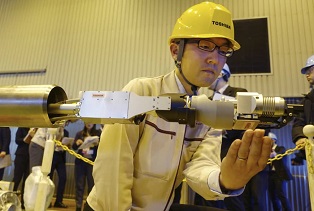
Jun Suzuki, a Toshiba ESS group manager for the project said:
"Until now we have only seen those deposits, and we need to know whether they will break off and can be picked up and taken out. Touching the deposits is important so we can make plans to sample the deposits, which is a next key step."
The issue is that there might not be anything of value to pick up with the robot’s tongs when the robot goes down into the reactor in February of this year. However, the engineers at Toshiba say if the robot is unable to lift anything out of the reactor, that will also be a key finding. The Fukushima Meltdown aftermath is an engineering conundrum of epic proportions, and it's not over yet. Perhaps the engineers may have just figured out how to get closer to ending it with their novel tong-robot. Even if it's by taking baby steps.
Works Cited
“Toshiba Unveils Robot to Probe Melted Fukushima Nuclear Fuel.” Phys.org - News and Articles on Science and Technology, Phys.org, phys.org/news/2019-01-toshiba-unveils-robot-probe-fukushima.html#jCp.
“Toshiba Unveils Robot with Tongs to Probe Melted Fukushima Nuclear Fuel.” The Japan Times, www.japantimes.co.jp/news/2019/01/29/national/science-health/toshiba-unveils-robot-tongs-probe-melted-fukushima-nuclear-fuel/#.XFCmWVwzZPY.
- Details
- Written by: Quintus Potgieter
South Africa's energy utility is in dire straits. On the 11th of February 2019, the utility's engineers implemented Stage 4 load shedding on South Africa's main energy grid. Stage 4 load shedding indicated that the country was short 4,000MW of the peak capacity requirement of 27,000 MW due to what the utility called ‘continued pressure’ on the national grid.
The utility has 45,000 MW of energy capacity installed, but cannot meet the peak demand of 27,000MW. Experts say the current situation reeks of gross incompetence at the very top levels of management at Eskom.
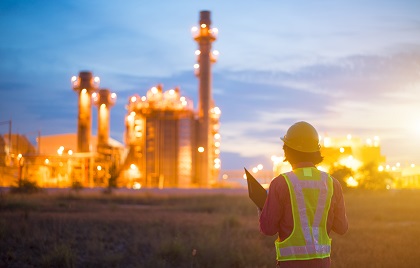
The country has never experienced Stage 4 load shedding in its history but is well acquainted with Stage 2 which the country saw intermittently in 2018. The new stage meant that South Africans would see their lights turned off twelve times in the space of four days.
Eskom pointed to the fact that there are six generators not functioning correctly in the country. Moreover, the utility's mega power stations —Medupi and Kusile — reportedly have major design and technical flaws that are causing the stations to underperform. What is clear is plant breakdowns, a lack of plant maintenance, a shortage of trustworthy engineers, and poor management of the energy grid, in general, has led to an energy crisis in South Africa.
The impact of the power cuts reportedly costs the country R2.5 billion (USD $181 million) in business revenue every day the lights are off.
South African President Cyril Ramaphosa recently delivered a State of the Nation address wherein he declared that Eskom would be unbundled. It would be broken up from one large organization and divided into three organizations.
This seems to have rung the alarm bells of the National Union of Mineworkers, the National Union of Metalworkers, the South African Communist Party and the Economic Freedom Fighters. They believe that the utility should continue to be state-owned, and assert that the unbundling of the organization points to the likelihood of privatization in the near future. If privatization follows, the previously mentioned groups may protest.
The financial problems Eskom has undergone in the last decade has led to incredible uncertainty for electrical engineers across the organization. The utility was R40 billion rand in debt in 2008. Ten years later, the debt has risen to over R400 billion.
Eskom has also been helping electrical engineering students complete their tertiary education with financial assistance in the form of bursaries. Upon graduation, the electrical engineers would have to work for Eskom to pay off the bursary. However, graduates who received bursaries from the parastatal in the last four years were informed at the beginning of 2019 that the salaried work they were to do was no longer available due to the financial trouble the organization is in.
Most worryingly, the utility has asked the prospective engineering staff that cannot work for the organization after graduation to sign an addendum to postpone the working obligation until they have recovered financially.
This means the graduates must either wait for the parastatal to turn a profit, or must go and find a job in the industry - but might face a disruption when the parastatal asks for them to return to work to repay their debt. Alternatively, the organization could write the employment contracts off. Nonetheless, the utility is disrupting the lives of electrical engineers in South Africa and stringing them along, leaving them in a state of limbo in their careers.
President Ramaphosa says that he is ‘shocked and angry’ at the events that have transpired in the Eskom debacle. He has also been quoted saying that the parastatal can no longer go about their business with all of their eggs in one basket. Diversifying the way Eskom does business seems to be in the country’s best interest.
However, privatization is not on the cards just yet. That, according to Public Enterprises Minister Pravin Gordhan who told media:
"In the Sona last week, the president did not talk anything about privatization. We are going to bring in external power stations engineers, get an independent audit on exactly what's going on so that we put Eskom back on track and give South Africans the assurance that we have an entity that is able to give us the energy security we require.”
Works Cited
“Load-Shedding Has Entered a Third Consecutive Day and Continues to Affect Most South Africans.” YouTube, YouTube, 12 Feb. 2019, youtu.be/k4vLv0f8b2U.
Dentlinger, Lindsay. “Pravin Gordhan Concedes Eskom Is Facing Massive Problems.” Eyewitness News, Eyewitness News | EWN, 12 Feb. 2019, ewn.co.za/2019/02/12/pravin-gordhan-concedes-eskom-is-facing-massive-problems.
- Details
- Written by: Quintus Potgieter
Today is International Women's Day. EIT is celebrating the women who are currently filling positions in the engineering industry across the globe. However, most experts are cognizant that more needs to be done to encourage women to enter the engineering industry.
The World Economic Forum reports that women account for just 11% of employees globally in architecture and engineering. The number is shockingly low, but the fight for women’s representation in engineering is beginning to gain traction.
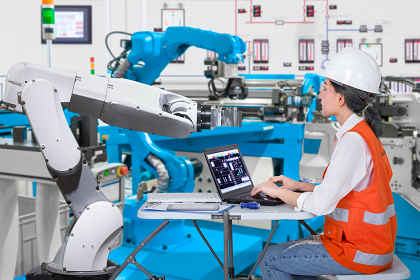
Microsoft and KRC Research conducted a study on the STEM industry named Closing the STEM Gap: Why STEM classes and careers still lack girls and what we can do about it.
Dr. Shalini Kesar, Associate Professor at the Department of Computer Science & Information Systems at the Southern Utah University, writes:
“For years, girls and young women have been a critical missing part of Science, Technology, Engineering and Math (STEM) studies and careers. The stubborn gender disparity in STEM fields has sparked important debates on the underlying reasons. Some attribute the gender disparity to social and infrastructural factors, lack of mentors and role models, and lack of awareness about what these fields offer in terms of educational and career opportunities.”
She says the archaically held view that engineering is ‘boring' and ‘only for boys' dissuades females from joining the industry. The report says girls ‘have a hard time picturing themselves in STEM roles.'
So, what can be done to convince girls that STEM is cool, a great career choice, and an industry to stay in until retirement? Schools are saying it starts in the classroom at an early age — STEM subjects and after-school clubs are the perfect way to do that.
Clubs for girls
Microsoft and KRC Research report that 44 percent of middle-school girls who participated in STEM clubs or activities, said they would likely continue engineering studies after school. Only 15 percent of girls who were not in STEM clubs or activities said they would pursue engineering studies after school.
The numbers (seemingly) don't lie: educators should implement better mechanisms inside their schools to get girls interested in STEM.
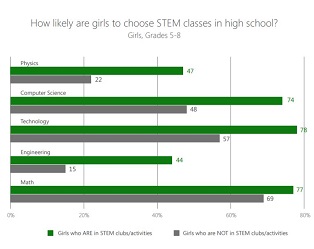
Another way to encourage young women to get involved in STEM fields is through mentorship programs with successful female engineers. Essentially, attracting and retaining females in STEM industries should be prioritized in a world calling for equal representation.
Dr. Shalini Kesar would agree and chalks the confidence she has in herself as a woman in STEM to the spurring on her parents did when she was younger. She wrote:
“My parents used to tell me that, ‘even if you are one drop of water in an ocean, it is those drops combined that make the ocean.’ Across southern Utah, I see a domino effect: when one girl sees the power in STEM and computing, she becomes a role model for her friends and community.”
Works Cited
“Our Insight, Your Breakthrough.” KRC Research, www.krcresearch.com/.
“The Engineering Mystery: Where Are the Women?” The Globe and Mail, The Globe and Mail, 6 Mar. 2019, www.theglobeandmail.com/business/careers/article-the-engineering-mystery-where-are-the-women/.
- Details
- Written by: Quintus Potgieter
In the United States, the Midwest and Northeast have shivered their way through a winter they won't forget. They are calling it the coldest temperatures in a generation. If boiling water was thrown into the air, it would instantly freeze. The deep freeze is reminiscent of the Sci-Fi film The Day After Tomorrow.
The North Polar Vortex has caused these freezing conditions — it pushed Chicago's temperatures down to -46 degrees Celsius. That is colder than Antarctica, Alaska and the North Pole.

The vortex was disrupted at the north pole, ejecting strong winds high up in the atmosphere, traveling southward. These offshoots of the vortex retained the cold from the Arctic region and carried these to parts of America.
A state of emergency has been declared in Wisconsin, Illinois, and Michigan.
The wholly adverse side effects of the cold snap were the fatalities caused by it. The vortex affected the lives of more than 89 million people.
Schools were shut down, flights canceled, and the post office had to abandon their operations as well.
The engineering challenges
One of the biggest concerns with a deep freeze this potent was the infrastructure. How would it cope with the freezing temperatures? The first to freeze was the water infrastructure — the water mains froze over, essentially cutting the water off.
With winds picking up in the Chicago area, many were at risk of being without electricity as branches fell onto power lines. The lower temperature can also cause overhead power wires to contract and cause breakages and result in power outages. Some areas in Chicago were without power as the cold air was dumped on the city.
Consequently, engineers had to be called out to restore electricity to customers.
Soon after the polar blast came down on Chicago, the train tracks became a concern in the cold temperatures too. Reports started flying in that they were beginning to ice over completely. Civil engineers sprung into action to prevent the tracks from contracting and cracking due to the cold.
The engineers utilized the gas-fed system already fitted on the tracks to keep the flames going. In Chicago, the system is used during normal winters anyway — but this time it was working to its fullest extent. With the contracting of the steel, the snapping of the railways where they are bolted is possible. The fire allows the rail to expand again, where they can then be re-bolted or welded to the other tracks.
Experts are saying with the United States seeing more bomb cyclones and polar vortexes, closer attention should be given to climate events. This is because of the engineering works required before and after an incident. Climate change is proving that aging infrastructure globally may not be ready to withstand these events.
Works Cited
Gstalter, Morgan. “Chicago Using Fire to Keep Rail Tracks from Freezing in Polar Vortex.” TheHill, The Hill, 30 Jan. 2019, thehill.com/homenews/state-watch/427654-chicago-using-fire-to-keep-rail-tracks-from-freezing-in-frigid.
Williams, Corey. “Polar Blast Envelops U.S. Midwest, Strains Aging Infrastructure.” CP24, 30 Jan. 2019, www.cp24.com/world/polar-blast-envelops-u-s-midwest-strains-aging-infrastructure-1.4274848.
- Details
- Written by: Quintus Potgieter
Industrial automation can transform the landscape of a country's workforce and economy.
Countries are transitioning from mining economies, into manufacturing economies with the sometimes unseen fourth industrial revolution's slow march.
Berg Insights reported that 4.6 million wireless devices were shipped globally in 2018 for the purpose of industrial automation. Industrial automation accounted for six percent of newly connected IoT nodes. It also meant that the number of devices connected for Industrial Automation reached 21.3 million in 2018.

Wireless devices are flowing into the industry replacing previous technologies that do not have the kinds of monitoring and data generating technology that modern-day sensors and communication devices do.
The Berg Insights report also points out that smart wireless devices monitoring the entire manufacturing process will lead to more ‘predictive maintenance.' The likelihood of manufacturing equipment lasting longer than its predecessor has increased with the new Industry 4.0 technology emerging in the industry. As a result, there will be less wasting of money for maintenance and more for the payment of employees.
Rockwell Automation's On the Move event for 2019 was held in India. It saw industry leaders encouraging the country to embrace automation to turn India into a manufacturing economy.
Rockwell Automation is so interested in growing the manufacturing output of India that they have recently branched into the country. Dilip Sawhney, Managing Director of Rockwell Automation India, said:
“We want to take the lead in building India’s first industry 4.0 ecosystem of partner companies that will create solutions for The Connected Enterprise that can analyze machine conditions in advance to avoid breakdown and enhance productivity but also improve on quality and compliance parameters.”
John Watts, Regional Marketing Director, for Asia Pacific at Rockwell Automation added:
“Globally, digital-induced disruption is inevitable. To maintain and improve global competitiveness, Indian manufacturers need to accelerate the adoption of Industry 4.0. While India has a lot of catching up to do in this respect, it can accelerate digital transformation by leveraging its strengths in the IT services sector and tapping the entrepreneurial spirit seen in the start-up sector.”
The experts at Rockwell believe that if India adopts more automation technologies, their combined factory output would make manufacturing a US$ 1 trillion business by 2025. Rockwell Automation has partnered with L&T, Cisco, Microsoft, Endress+Hauser, and Wipro Infrastructure Engineering to help develop smart manufacturing solutions in India.
Works Cited
“Industry 4.0 Tech Can Triple India's Factory Output, Says Rockwell Automation.” Tech Observer, 22 Jan. 2019, techobserver.in/2019/01/22/industry-4-0-tech-can-triple-indias-factory-output-says-rockwell-automation/.
IoT.Business.News. “The Installed Base of Wireless IoT Devices in Industrial Automation Reached 21.3 Million in 2018.” IoT Business News, IoT Business News, 21 Jan. 2019, iotbusinessnews.com/2019/01/21/62655-the-installed-base-of-wireless-iot-devices-in-industrial-automation-reached-21-3-million-in-2018/.
- Details
- Written by: Quintus Potgieter
Making computers think like humans is undeniably the next frontier that scientists and engineers are to trying to reach.
However, machine learning, a field of computer science that programs computers with the ability to learn from data and make informed, adaptive, dynamic predictions, is currently reinventing the wheel in engineering industries.
In the last decade, technology has taken a gigantic leap forward. Machine learning has empowered these technologies, and today we have virtual assistants, speech recognition, incredible consumer products, and more.
Governments around the world are now trying their best to out-AI other governments. And that’s a good thing for future engineers.

It seems that China has sent alarm bells ringing around the world with their artificial intelligence aspirations and apparent capabilities.
The United States of America doesn't want to be left behind. The White House just published an executive order on ‘Maintaining American Leadership in Artificial Intelligence.' President Donald Trump said:
“We’re on the verge of new technological revolutions that could improve virtually every aspect of our lives, create vast new wealth for American workers and families, and open up bold, new frontiers in science, medicine, and communication.”
The new executive order is a national strategy with the intention of prioritizing funding for ‘fundamental AI research and computing infrastructure, machine learning, and autonomous systems.'
Engineers have managed to make the rest of the world perk up and listen, with their innovative inventions utilizing artificial intelligence and machine learning.
However, it is not only China and America throwing their hats in the ring. Forbes Magazine reports that Russia, Japan, Estonia, Israel and Canada, are major global players in the AI and machine learning sectors too.
Most prospective engineering students globally, however, are eager to learn more about artificial intelligence and machine learning. They are seeking to earn qualifications in the space as well.
If the benefits of AI, machine learning and autonomous systems are clear, then many other countries should turbo-charge their uptake of the studying of these sectors.
Engineers studying at this very moment might have never been introduced to the learning materials that could assist with becoming knowledgeable about machine learning and artificial intelligence. So, how does the empowering of all engineers and technologists who could bring about the peak of the fourth industrial revolution begin?
Globally unlocking AI and machine learning
The Engineering Institute of Technology is presenting a Professional Certificate of Competency in Machine Learning and Artificial Intelligence. The course will begin on 13 May 2019.
In a short three months, students can become competent in the following areas of artificial intelligence and machine learning:
- Demonstrate an understanding of machine learning and its basic techniques
- Solve problems using search algorithms
- Examine and discuss Simultaneous Localization and Mapping (SLAM)
- Solve problems using supervised learning methods
- Use WEKA software for data analysis and machine learning
- Solve problems using mathematical optimization
- Use MATLAB for machine learning
The course is delivered industry lecturers with more than 15 years of experience in the development and management of artificial intelligence. The course teaches students incredible problem-solving skills in the machine learning world and trains them in building algorithms to automate processes.
To join the course, all the students need is a computer with an adequate Internet connection. At the end of the course, the future AI whizzes will receive a certificate of competency and be ready to learn and apply what they have learned in the actual industry.
Enquire about the course today.
Works Cited
“Artificial Intelligence for the American People.” The White House, The United States Government, www.whitehouse.gov/briefings-statements/artificial-intelligence-american-people/.
Minevich, Mark. “These Seven Countries Are In A Race To Rule The World With AI.” Forbes, Forbes Magazine, 5 Dec. 2017, www.forbes.com/sites/forbestechcouncil/2017/12/05/these-seven-countries-are-in-a-race-to-rule-the-world-with-ai/#181ff94f4c24.
“Professional Certificate of Competency in Machine Learning and Artificial Intelligence.” Engineering Institute of Technology, www.eit.edu.au/cms/courses/electronic-engineering/professional-certificate/in-machine-learning-and-artificial-intelligence.
- Details
- Written by: Quintus Potgieter
India's most famous civil engineer, Sir Mokshagundam Visvesvaraya, once said: ‘Work is worship.'
Gustave Eiffel, the French civil engineer responsible for the Eiffel Tower, said: “Can one think that because we are engineers, beauty does not preoccupy us or that we do not try to build beautiful, as well as solid and long lasting structures? Aren’t the genuine functions of strength always in keeping with unwritten conditions of harmony? Besides, there is an attraction, a special charm in the colossal to which ordinary theories of art do not apply.”
Marvels of civil engineering are evident throughout history. Even today, humans are trying to push the boundaries of what is possible.
However, what exactly draws prospective engineers to the civil engineering profession? Why do civil engineers do what they do? How can they improve the world in the future?

The Civil Engineering Contractors Association, a construction organization in the United Kingdom, wants to answer those questions. They have published a report entitled: ‘The social benefits of infrastructure investment.'
The association brings together 300 civil engineering member companies across Scotland, Wales, and England. Altogether, they represent 70 to 80 percent of all civil engineering activity in the UK. They are present in critical sectors including transport, energy, communications, waste, and water. With the uncertainty of Brexit looming, the association is reminding civil engineers to remain dedicated to the noble profession.
Building a better world?
The association says that building infrastructure leads to social cohesion. However, more needs to be done to establish a purpose for the workers building the infrastructure that generates the ecosystem of a city. In the report, they write:
“The social and economic benefits of infrastructure are closely related. While quality of life, health and social inclusion have become increasingly important factors in long term economic prosperity, the mechanisms by which infrastructure influences these factors are considered much less measurable than simple economic benefit.”
The report encourages civil engineers to find the gaps in society where they could assist in developing hubs of business and prosperity. They say this is attainable by starting within their communities. They write:
“Solving Britain's housing crisis is not simply a question of building a certain number of new homes, but ensuring that there are opportunities for people to have access to the housing they need where they want to live.”
Investment into infrastructure in communities who might need it most develops, the report says, ‘more productive and interesting work that enables people to develop their skills and knowledge.' Thus, civil engineering can help others find their way in their careers too.
Arup, an independent firm of designers, planners, engineers, consultants and technical specialists with offices in the UK, is also redefining the fashion in which they instill social value in their projects.
Arup associate director for sustainability and social value, Alison Ball, talking to the New Civil Engineer publication said:
“Many things come together to form the social value of the project, such as health and wellbeing, crime and safety, identity, pride and belonging, community cohesion and diversity, geography, and stakeholders. We also think that added into this we need to take a total value approaching asking: ‘what are the natural and environmental benefits?’, and the negatives, the financial values, as well as the economic values?”
In 2018, the public opinion of the social value of civil engineering projects was unfavorable due to highly publicized structural failures in the United States and Italy. It produced fresh cynicism for civil engineering projects that lack constant maintenance.
The year 2019 will test already existing infrastructure and its maintenance. Building new structures while not maintaining the old infrastructure will undercut the social value design that firms and new civil engineering companies are trying to contribute to.
Consequently, prospective engineers entering the industry must ensure that wherever they find themselves in the industry, they do a good job and pay attention to detail.
Works Cited
16 January, 2019 By Connor Ibbetson. “Debate | Determining the Social Value of Projects.” New Civil Engineer, www.newcivilengineer.com/business-culture/debate-how-can-engineers-determine-the-social-value-of-projects-/10038890.article.
“Home.” CECA, www.ceca.co.uk/.
